Abstract
Remote sensing datasets offer robust approaches for gaining reliable insights into forest ecosystems. Despite numerous studies reviewing forest aboveground biomass estimation using remote sensing approaches, a comprehensive synthesis of synergetic integration methods to map and estimate forest AGB is still needed. This article reviews the integrated remote sensing approaches and discusses significant advances in estimating the AGB from space- and airborne sensors. This review covers the research articles published during 2015–2023 to ascertain recent developments. A total of 98 peer-reviewed journal articles were selected under the Preferred Reporting Items for Systematic Reviews and Meta-Analysis (PRISMA) guidelines. Among the scrutinized studies, 54 were relevant to spaceborne, 22 to airborne, and 22 to space- and airborne datasets. Among the empirical models used, random forest regression model accounted for the most articles (32). The highest number of articles utilizing integrated dataset approaches originated from China (24), followed by the USA (15). Among the space- and airborne datasets, Sentinel-1 and 2, Landsat, GEDI, and Airborne LiDAR datasets were widely employed with parameters that encompassed tree height, canopy cover, and vegetation indices. The results of co-citation analysis were also determined to be relevant to the objectives of this review. This review focuses on dataset integration with empirical models and provides insights into the accuracy and reliability of studies on AGB estimation modeling.
1. Introduction
Forest aboveground biomass (AGB) estimation and mapping is pivotal in understanding and managing carbon stocks and contributing to global efforts in climate change mitigation. Despite its significance, achieving accurate, large-scale assessments has remained challenging within the scientific community [,,]. The tropics have four times larger gross emissions and removals than temperate and boreal ecosystems []. Deforestation is the main contributor to global forest carbon loss, which indirectly reduces the carbon absorption capacity of land and forest ecosystems []. The largest carbon pool is aboveground biomass (AGB), which varies widely depending on disturbance. Characterizing the Earth’s climate system and fighting climate change requires accurate AGB estimation, a vital climate variable []. This creates a need for remote sensing datasets, integrated with cost- and time-efficient approaches, to map and estimate forest aboveground biomass.
Advances in remote sensing using freely available datasets offer new opportunities for monitoring large-scale forest ecosystems (medium spatial resolution images) [,,]. They have made it possible to monitor and map forest cover and changes over large coverage at regular intervals with reasonable accuracy []. Medium spatial resolution images are familiar sources for regional biomass estimation. Since coarser resolution data offer superior exchanges between temporal and geographical resolution and coverage, they are frequently utilized in analyzing forest AGB at the regional and global levels []. Active and passive remote sensing techniques make the estimation more accurate and time-efficient at local and regional levels []. To some extent, spaceborne Light Detection and Ranging, together with radar sensors and unmanned aerial vehicles, permits the determination of emission parameters previously obtained from field inventory data []. The multiple satellite observations of SAR backscatter provide new insights into terrestrial woody AGB’s spatial distribution and magnitude []. The integration approaches of SAR datasets with field inventory data are utilized to estimate the forest growing stock and assess its relative changes []. More recently, large-scale methods to map AGB have generally combined datasets from different sensors to overcome their limitations []. Integration of optical (passive) data with LiDAR (active) has produced more accurate estimates of the AGB []. Spaceborne remote sensing is currently the most helpful method for monitoring the AGB globally []. Active remote sensing techniques, such as LiDAR and SAR systems, are more sensitive to the vegetation structure than optical sensors []. The most accurate way to measure a forest’s vertical structure is with LiDAR, which can also increase the accuracy of estimating the forest’s aboveground biomass when combined with some optical images []. It tracks disturbance and regeneration in boreal, temperate, and tropical forests and provides insights into forest structure characteristics []. The other dataset is a spaceborne LiDAR imager, the Global Ecosystem Dynamics Investigation (GEDI), that estimates aboveground biomass and provides accurate information about forest structure []. In this case, obtaining comprehensive mapping of forest stand volume using GEDI data without optical sensor images will still be difficult because of spatial and temporal limitations []. GEDI products’ height profile and AGB density value were fused with optical datasets (Landsat-8) to classify the forest type in Mediterranean surroundings []. Empirical models utilized globally distributed coincident fields and airborne LiDAR datasets to create the GEDI-L4A (25 m footprint) product []. These sensors have been used to overcome and reduce individual limits in biomass estimation due to the low sensitivity of the biomass of forest components. These limitations have resulted in everyday issues such as saturation and partial observation []. Many modeling techniques were used to minimize the AGB estimate uncertainties at multiple spatial scales []. Rapid-Eye satellite images were employed with a random forest model and k-nearest neighbor method for tree species prediction and biomass mapping []. Synthetic aperture radar and multi-spectral imagery data using non-linear regression analysis were used to map AGB []. A random forest model and spaceborne L-band microwave vegetation opacity measurement were used to map changes in aboveground biomass across climatically driven events []. The integration of optical datasets with field plot data was used to estimate AGB using K-nearest neighbor imputation models []. The stock volume was assessed using the values of Sentinel-2 imagery and land-cover classification based on the same image, which was learned using the MODIS data following the empirical approach [].
Previously, many studies have attempted to review the assessment of forest aboveground biomass by remote sensing techniques. Ahmad et al. [] showed the importance of high-resolution optical satellites by estimating AGB using linear and non-linear regression with satellite-derived independent variables. Gyamfi-Ampadu E et al. [] describes how remote sensing applications monitor tropical and sub-tropical natural forests, emphasizing change detection, AGB, tree species diversity, and their identification at the regional scale. The approaches of satellite remote sensing to assess AGB from national to global tropical forests are explained by Abbas S. et al. []. Turton A. et al. [] documented statistical methods to improve forest aboveground biomass estimates and their changes. Mutanga O. et al. [] attributed the spectrum saturation situations observed from remote sensing datasets to the high density of vegetation globally. However, synergetic integration methodologies for mapping and estimating forest AGB have not yet been synthesized in these evaluations.
This paper reviews the outcomes of synergistic approaches using diverse platform datasets for forest AGB mapping and estimation through remote sensing-based technologies. It gives a comprehensive insight into integrating such datasets, pointing out possibilities for further research and identifying gaps in order to improve current AGB mapping and estimate procedures, primarily focusing on information extraction and remote sensing techniques.
The approaches and workflows for estimating forest aboveground biomass using multiple remote sensing platforms can be segmented into three primary categories. First, spaceborne platform datasets have the potential to identify forest land on a larger footprint to estimate biomass using its spectral, textural, and height information. Second, airborne platform datasets can provide high spatial resolution data to estimate biomass on a local scale. Lastly, space- and airborne platform datasets have the potential for a process-based understanding to develop a synergic workflow for local- to large-scale AGB estimation and mapping.
Consequently, this research aims to (a) systematically review and analyze the effectiveness of multi-platform integration approaches in forest AGB estimation and (b) identify the most commonly used remote sensing datasets and regression models in these integrated approaches. Through this analysis, this study aims to provide insightful information about the current state of AGB mapping, assess the lessons learned from past research, and propose a future agenda to guide ongoing and future studies in this field.
2. Materials and Methods
The analysis of a systematic literature review (SLR) is a useful way of assessing ideas or indications within a specific field and determining whether or not individual hypotheses are accurate and powerful. The PRISMA framework was consulted in preparation for determining the specifics of this review process. Section 2.4 indicates that these papers were carefully appraised and filtered using previously established quality criteria. The fundamental PRISMA guidelines were followed in executing and publishing the review results. The complete workflow of this review is explained as shown in Figure 1.
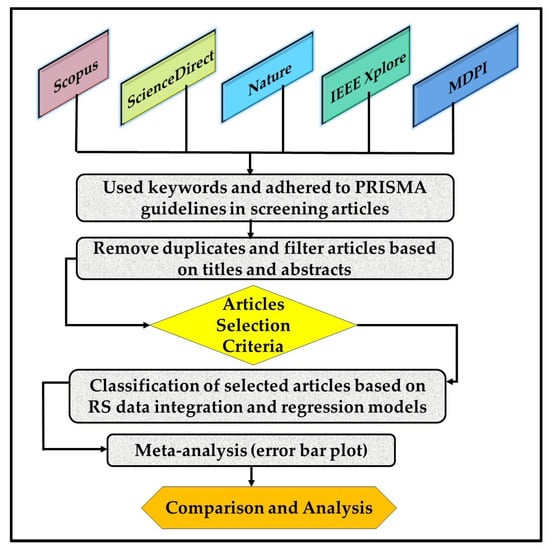
Figure 1.
Workflow of literature review. Grey color represents the processing steps, yellow color represents the article selection criteria, and orange represents discussion and analysis.
2.1. Search Approach and Terms
To attain the objectives of this review, a Boolean operator known as “AND” was combined with three keywords: “Mapping, Forest Aboveground Biomass Estimation, and Remote Sensing”. This set of keywords was applied as a query string in the selected databases. These three keywords helped make the published articles as accessible to review as possible. It was desired that all the published research articles, mostly in English, be included in this SLR so that no research papers in the given time frame were overlooked.
2.2. Timeline and Sources of Data
We searched through all mentioned digital data sources from 2015 to 2023, considering the current technology developments in forest aboveground biomass calculation and remote sensing. Since synergistic remote sensing platform data like Landsat-8, Sentinel-2, and GEDI datasets are a current focus of interest for researchers and would help highlight recent developments in this sector, the short period from 2015 to 2023 was selected We created a search strategy to customize this systematic search method to find pertinent literature. This search method was customized for five databases (Scopus, Science Direct, Nature, IEEE Xplore, and MDPI) to thoroughly locate pertinent papers for this review.
2.3. Selection Process
The selection criteria for research articles were based on the PRISMA process flow to categorize the relevant articles. This process is presented by Kitchenham [] and includes four steps. Main research articles from sources were collected in the first step, along with identifying and removing duplicated articles from the databases. The second step was to screen the collected articles based on titles and abstracts to check their relevance to the review article objective. The third stage entailed comparing the articles’ quality standards to determine whether they were to be included or excluded, determining their eligibility. The final stage involved adding up all the research articles for quantity synthesis.
Using the abovementioned process, 1076 studies were found from the abovementioned databases. This was because most of the research articles used the keywords of “mapping”, “forest aboveground biomass estimation”, and “remote sensing”. These keywords are used in many articles available in the ScienceDirect database (812) that do not have any relevance to forest biomass estimation, e.g., [,,], which were not included. Similarly, soil-related articles, e.g., [,], and even those with carbon-pool-related applications, were excluded. Among all the databases, 65 duplicated articles were also removed at this stage. After that, the search was narrowed by reviewing and removing publications without a quality assessment based on the exclusion criteria for mapping and estimating aboveground biomass in forests. At this stage, 245 research articles had filtered through. For checking the quality of articles as per the inclusion criteria, among all the databases, 98 publications had information which was included in the review of this article. These articles were further classified into three categories: spaceborne, airborne, and space- and airborne platforms. This workflow is shown in a flowchart that summarizes this article’s screening method in Figure 2.
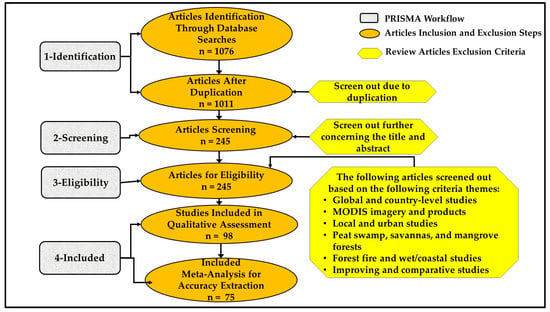
Figure 2.
Flowchart of article screening as per selection criteria.
We extracted the year of publication of each article, the details of the dataset, the type of forest, field data, its source, the region of study, and the accuracies for the models of forest estimation. Table 1 depict the number of scrutinized articles by year and database.

Table 1.
Database-wise distribution of the articles and their allocation in the three categories.
2.4. Inclusion and Exclusion Criteria
This section discusses and covers the eligibility criteria that have been formulated and implemented in place regarding the research articles scrutiny. As per the developed criteria, research articles from the mentioned source journals were included from 2015 to 2023. The articles were selected based on titles and abstracts that mainly mentioned mapping and estimating forest aboveground biomass. The detailed process of the article selection was discussed in Section 2.1, Section 2.2 and Section 2.3. This systematic literature review (SLR) excluded non-English articles and those lacking remote sensing for mapping and forest aboveground biomass estimation. Similarly, other studies (posters, abstracts, conference publications, and Wikipedia data) were excluded from the SLR. Other research articles concerned with the study area (global and national scale, MODIS imagery and products, local and urban scale, peat swamp, savannas, mangrove forests, forest fire, and wet/coastal forest studies, and studies on improving methodologies and estimation comparative studies) were also screened out from this SLR. While forest scale was not explicitly analyzed in this review, studies carried out at a local or hyper-local scale were not included. The published research articles with evaluation criteria (R2) were included in this review. The twenty-three (23) research studies having other accuracy criteria (Standard Deviation, RMSE) were included in this SLR. This resulted in the exclusion of 23 articles from the selected 98 articles during the meta-analysis of the accuracy assessment. The meta-analysis was performed only on the rest of the scrutinized research articles (75), which used a coefficient of determination (R2). The qualitative analysis was performed on all 98 selected articles, as shown in Figure 2.
2.5. Quality Assessment Criteria
The next step was to create the SLR quality assessment criteria. To ensure the quality and relevance of the scholarly literature involved in the review process, the abstracts of the articles were scrutinized to analyze and purify them during its implementation. These articles followed different methods and approaches for forest aboveground biomass estimation and mapping. Part of the meta-analysis assessment included all the criteria used to evaluate outcomes, including the coefficient of determination. The papers selected were relevant to estimating and mapping aboveground biomass in forests and fully met the quality assessment criteria explained above in Section 2.3 and Section 2.4. The reliability of the selected articles was improved by using inclusion and exclusion criteria in quality assessment.
Mendeley Desktop v1.19.8 software was maintained and assisted with all these steps. This software also reliably performed research article association, citation, and bibliography [].
2.6. Segregation and Analytics
The scrutinized research studies were further categorized according to the use of spaceborne, airborne, or space- and airborne platform datasets for analysis. Country, study year, types of empirical models, remote sensing datasets, accuracy assessments, and forest biome insights were the key elements separated out for analysis. These analyses are explained in Section 3 of the Results and Section 4 of the Discussion to offer some insights. The majority of the selected publications used the coefficient of determination (R2), mean absolute error (MAE), normalized root mean square error (nRMSE), and root mean square error (RMSE) to evaluate the model accuracy. Of the above, the current review examined the coefficient of determination (R2) to measure the accuracy. This is because the evaluation by RMSE is based on the values of observation, which vary by type of forest and by region/country.
2.7. Scientometric Analysis
In this SLR, a scientometric investigation was also performed using CiteSpace Software 6.3.R1 Basic []. These analytics encompassed the webometrics, bibliometrics, and informetrics of the selected studies, further highlighting insights from the selected articles’ citations. An article’s citations and keyword connectivity were identified through this software. The node’s size showed the number of key phrases used in the literature analysis. The use of the above software has helped establish relationships between the publication’s titles and keywords, and has also aided in effective visualization.
3. Results
This is the most vital portion of this SLR. The results provide a comprehensive demonstration of the extracted information used in this study. The interpretation of data acquired from the article results and analysis is also described in the Discussion section of this SLR. The spatial distribution of the selected articles’ study areas is shown in Figure 3. Among a total of 98 selected studies, 54 were relevant to spaceborne platforms, 22 to airborne platforms, and 22 to space- and airborne platforms. Information regarding all articles (years, databases) is given in Figure 4 and Table 1.
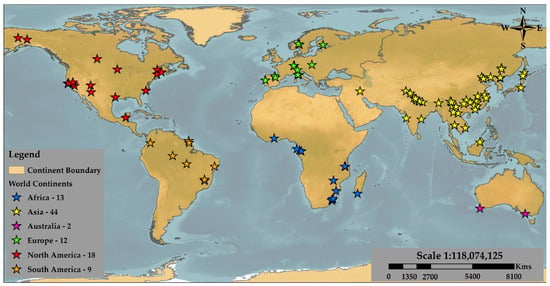
Figure 3.
Spatial distribution of selected article study areas.
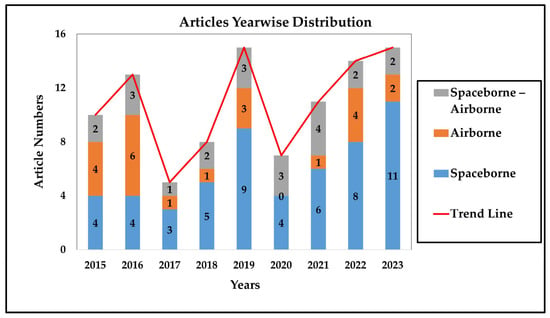
Figure 4.
Yearly distribution of the articles and their allocation in the three categories.
The maximum number of research articles (15) occurred in 2023 and 2019, followed by 2022, indicating a possible increase in research on forest aboveground biomass estimation and mapping in recent years, which will increase further with the launch of the ESA’s BIOMASS mission and the NASA–ISRO SAR mission (NISAR) and the continuity of GEDI datasets.
ScienceDirect was the most significant data source, with the maximum number of research publications (56), followed by MDPI (17) and Scopus (16).
The selected articles were classified into three categories (spaceborne, airborne, and space- and airborne) according to the taxonomical arrangement. Of the 98 articles, only 54 were relevant to spaceborne platforms, 22 were related to airborne platforms, and 22 were related to space- and airborne platform datasets.
3.1. Scientometric Analysis
CiteSpace software v.6.3.R1 is a powerful tool that offers citation analytics based on keywords, abstracts, and titles. Meanwhile, the meta-analysis followed the criteria defined in this review and the PRISMA framework guiding rules. Scientometric analysis offers detailed analytics related to citation catalogs like Web of Science (WoS) and Scopus. In this review, the articles were selected irrespective of the number ofcitations. Web of Science (WoS) provided 3244 citations to the scientometric scrutiny text list in CiteSpace Software for the selected articles the year-wise citation and publication trends as per the WoS analysis are shown in the graph in Figure 5. The citation trend line in the chart indicates that there was an increase in citations between the years 2015 and 2023. This further proves that scholars have actively shown interest in developing methods for mapping and estimating the aboveground biomass of forests using remotely sensed datasets in recent years. Thus, the 2015–2023 timeline selection was suitable, as evidenced by the citation trend graph.
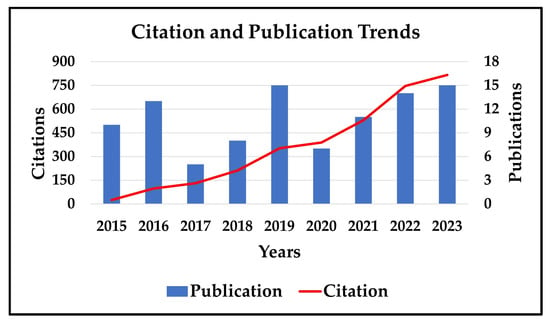
Figure 5.
Year-wise citation and publication trends (WoS).
A scientometric analysis for document co-citations of the scrutinized articles (98) was conducted using the default conditions with unlimited look-back years. In this study, the 292 merged network nodes for 1442 links show a link average amount of 4.93 per node. The outcomes of the co-citation clustering analysis are presented in Figure 6 and Figure 7, based on titles and keywords using CiteSpace. Among the clusters, ground biomass, optical satellite data, remote sensing data, Sentinel-2, and multi-sensor data synergy were the most relevant, followed by forest AGB, LiDAR, multi-sensor, laser scanning, and canopy height model. The critical theme of forest biomass estimation was also explored in the document co-citation analysis described in this review. This review used CiteSpace v.6.3.R1 to view the scholarly literature from 2015 to 2023. The analysis was performed on 20 May 2024, and it showed a network of 292 nodes and 925 edges with a density of 0.0218. Of all the nodes in the network, 1.0% were labeled, and the single most critical connected compound covered 100% of the network. The selection criteria consisted of LRF = −1.0 and G-index = 21. The pruned method used was Pathfinder, the weighted mean silhouette S = 0.8588, and modularity Q = 0.7364. The harmonic mean was found to be Q, S = 0.7929.
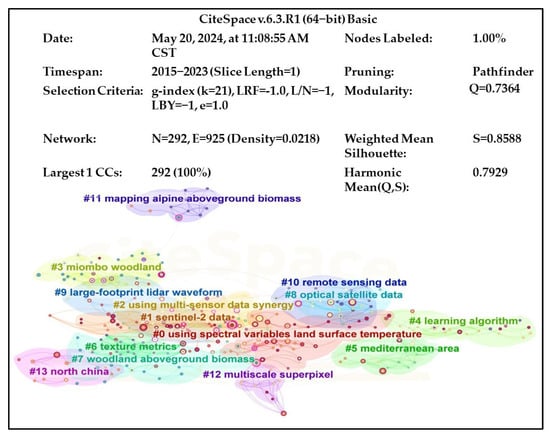
Figure 6.
Co−citation analysis based on titles using CiteSpace. Numbers show title importance, and different colors show their cluster strength [].
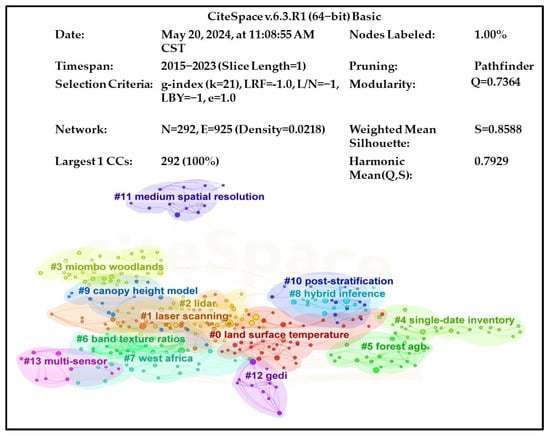
Figure 7.
Co−citation analysis based on keywords using CiteSpace. Numbers show keywords’ importance, and different colors show their cluster strength.
3.2. Forest Aboveground Biomass Estimation
The various sensors, comprising spaceborne, airborne, and space- and airborne datasets, were integrated to estimate forest aboveground biomass, field inventory, and survey data. Therefore, this section is further divided into three categories (spaceborne, airborne, and space- and airborne datasets) for segregation and analytics information to explore the various approaches and results adopted in each dataset section.
3.2.1. Spaceborne Datasets
Using spaceborne data provides an excellent perspective for estimating and mapping forest AGB using various empirical regression models. The frequently utilized spaceborne datasets include optical, SAR, and spaceborne LiDAR. These datasets have the potential to provide more reliable information on land reflection in light of spatial, temporal, and radiometric advances. Moreover, these spaceborne datasets were integrated with field inventory and field plot data using various regression models and provided reliable information. After having classified the selected articles, this section includes studies (54) that describe the use of spaceborne datasets for forest AGB estimation and mapping. The graphs, as shown below in Figure 8, display the frequency distribution of the research articles in terms of datasets, regression models used, and article frequency per year and country/continent-wise.
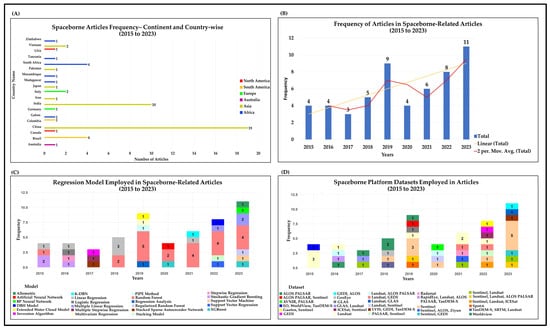
Figure 8.
Analysis of spaceborne dataset articles from 2015 to 2023. (A). Frequency distribution of articles country- and continent-wise. (B). Article frequency year-wise. (C). Year-wise frequency of regression models employed. (D). Year-wise frequency of spaceborne datasets employed.
These investigations were distributed geographically as follows: China (19), India (10), South Africa (4), Brazil (4), Italy (2), and Vietnam (2). Other countries were the USA, Pakistan, Japan, Mozambique, Madagascar, Iran, Germany, Gabon, Colombia, Canada, Zimbabwe, Tanzania, and Australia. These studies showed that spaceborne datasets, field data, regression models, and China (country) were unique characteristics pertinent to this integration approach. Most articles used the Sentinel (Sentinel-2 (6), Sentinel-1 and 2 (5)) and Landsat (Landsat-5, 7 and 8 (1), Landsat-7 and 8 (1), Landsat-5 (2), Landsat-8 (4)) imagery to estimate forest AGB, as shown in Figure 8D. Figure 9 shows a flowchart of spaceborne datasets, regression models used, and countries/continents.
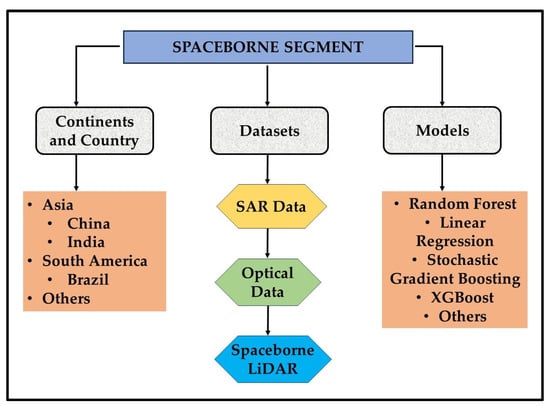
Figure 9.
Flowchart of the spaceborne category mentioning continents/countries, types of spaceborne datasets, and regression models employed.
The integration of different spaceborne datasets using regression models is essential not only to estimate forest AGB and its uncertainties but also to give information about which spaceborne datasets are valuable (coverage area, spatial and spectral resolution domain) to estimate biomass in a time- and cost-efficient manner. Therefore, a reliable selection of spaceborne datasets and regression models along with field data will not only aid in the estimation of forest AGB but also offer knowledge for utilization in decision-making for forest ecosystem management.
In this SLR, 54 papers described the utilization of spaceborne datasets to estimate forest AGB using regression models. Analysis of these selected articles (54) showed that twenty-three different regression models were used to integrate the spaceborne datasets with field inventory or field data. Among these selected articles (54), random forest (22) [,,,,,,,,,,,,,,,,,,,,,], linear regression (6) [,,,,,], multi-linear regression (3) [,,], stochastic gradient boosting (3) [,,], and XGBoost (2) [,] were the most common models employed for the application of spaceborne datasets. Other regression models were used only once [,,,,,,,,,,,,,,,,,].
3.2.2. Airborne Datasets
The most frequently used airborne platform datasets mentioned in this category included airborne LiDAR, Airborne Laser Scanning (ALS), and UAV datasets. These datasets with high spatial resolution can provide improved forest AGB estimations over a local area. Moreover, these airborne datasets were integrated with field inventory and field data utilizing regression models to produce accurate and reliable information about the forest AGB. After the classification, the airborne datasets category comprised 22 articles featuring using airborne datasets. The graphs shown in Figure 10 display the frequency distribution of research articles in terms of airborne platform datasets, regression models, year-wise frequency, and country/continent-wise.
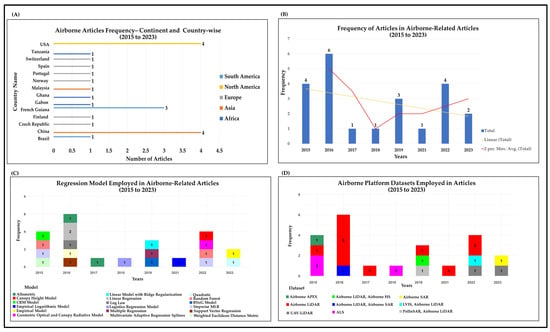
Figure 10.
Visualization of airborne dataset articles from 2015 to 2023. (A). Frequency distribution of articles country- and continent-wise. (B). Article frequency year-wise. (C). Year-wise frequency of regression models employed. (D). Year-wise frequency of airborne datasets employed.
These investigations were distributed geographically as follows: USA (4), China (4), and French Guiana (3). Other countries were Tanzania, Switzerland, Spain, Portugal, Norway, Malaysia, Ghana, Gabon, Finland, the Czech Republic, and Brazil. These studies showed that airborne datasets, regression models, and the USA and China (countries) were unique characteristics pertinent to this integration approach. Most articles used the Airborne LiDAR (11) and ALS (3) datasets for the airborne datasets to estimate forest AGB, as shown in Figure 10D. Figure 11 shows a flowchart of airborne datasets, regression models used, and country/continents.

Figure 11.
A flowchart of the airborne category mentioning the continents/countries, types of airborne datasets, and regression models employed.
Using regression models to integrate different airborne datasets is essential to estimate forest AGB and its uncertainties and to give information about which airborne datasets are valuable (coverage area and spatial and spectral resolution) to estimate biomass in a time- and cost-efficient manner. Therefore, a reliable selection of airborne datasets and regression models using field data will aid in the estimation of forest AGB. It shall also contribute towards technology utilization in improving estimation accuracies and reducing uncertainties.
In this SLR, 22 papers were found that described the utilization of airborne datasets to estimate forest AGB using regression models. In these selected articles (22), linear regression (2) [,], random forest (2) [,], and allometric equation (2) [,] models were employed the most. The other models were used once each in articles [,,,,,,,,,,,,,,,]. Linear regression and random forest were the most important models for the application of airborne datasets in forest AGB estimation.
3.2.3. Space- and Airborne Datasets
The most frequently used space- and airborne datasets mentioned in this category included airborne LiDAR, ALS, and UAV datasets, and optical, SAR, and spaceborne LiDAR datasets. These data integrations provide overall coverage of spatial, temporal, and radiometric variations within platform datasets to improve the estimations of forest AGB. Moreover, these space- and airborne datasets were integrated with field inventory/field data using various regression models and provided reliable information for the forest AGB estimation. After the classification, the space- and airborne datasets category comprised 22 articles describing the use of space- and airborne datasets in detail. In Figure 12, the graphs display the frequency distribution of research articles discussing spaceborne–airborne platform datasets, the regression models used, and country/continent-wise.
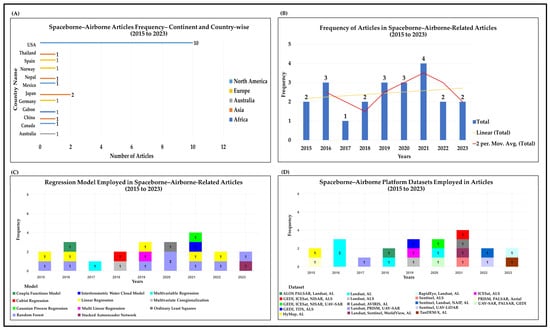
Figure 12.
Visualization of space- and airborne dataset articles from 2015 to 2023. (A). Frequency distribution of articles country- and continent-wise. (B). Article frequency year-wise. (C). Year-wise frequency of regression models employed. (D). Year-wise frequency of space- and airborne datasets employed (AL = airborne LiDAR).
These investigations were distributed geographically as follows: USA (10), Japan (2), and China (1). Other countries were Thailand, Spain, Norway, Nepal, Mexico, Germany, Gabon, Canada, and Australia. These studies showed that space- and airborne datasets, regression models, and the USA (country) were unique characteristics pertinent to this integration approach. In the space- and airborne datasets category, most articles used airborne LiDAR, Landsat, Sentinel, and GEDI datasets to estimate forest AGB, as shown in Figure 12D. Figure 13 shows a flowchart of space- and airborne datasets, the regression models used, and the countries/continents.
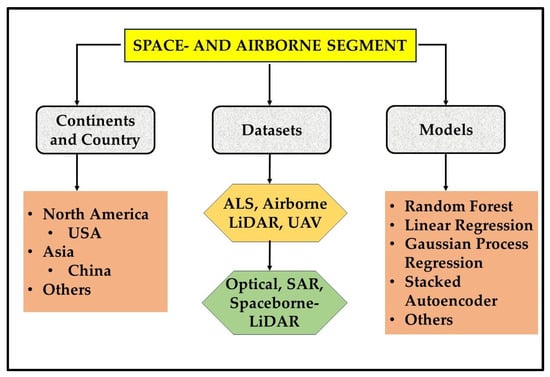
Figure 13.
A flowchart of space- and airborne category mentioning continents/countries, types of spaceborne–airborne datasets, and regression models employed.
Using regression models to integrate different space- and airborne datasets is essential to estimate forest AGB, reduce the uncertainties, and give information about which space- and airborne datasets are helpful with respect to area, resolution, and forest type.
In this SLR, 22 papers described using space- and airborne datasets to estimate forest AGB using regression models. Among these selected articles (22), eleven regression models were used to integrate space- and airborne datasets with the field inventory or field data. Among these selected articles (22), random forest (8) [,,,,,,,] and linear regression (5) [,,,,] were the most often used models, and the other models were employed once [,,,,,,,,].
3.3. Accuracy Assessment Analytics
A coefficient of determination (R2) is a statistical metric defining important insights about how a model works and how variance is distributed between independent and dependent variables. Analysis of the coefficients of determination (R2) is depicted as an error bar plot to obtain the performance information for the forest AGB estimation regression models. Each point represents the mean R2 value for a study, while the horizontal lines (error bars) show the range from minimum to maximum R2 values. These have been used to show how various research workflows relevant to remote sensing datasets and regression models performed in terms of consistency, reliability, and range of R2. This section is also divided into three sections: (i) spaceborne analysis, (ii) airborne analysis, and (iii) space- and airborne analysis, organized in terms of the regression models and datasets used.
3.3.1. Spaceborne Analysis
Accuracy assessment for the spaceborne platform datasets was carried out for datasets, and a regression model on the article’s coefficient of determination (R2) was used. Forty-eight (48) articles [,,,,,,,,,,,,,,,,,,,,,,,,,,,,,,,,,,,,,,,,,,,,,,] were employed for further analysis, as they had R2 values among the total classified articles (54). The error bar plot of R2 and the regression model used, as shown in Figure 14, showed that the random forest regression model (21) was the only model with a reasonable number for analysis, followed by linear regression (5). The highest number of studies with the random forest model were conducted in China (6). Domingues G. et al. [] achieved an R2 of 0.95 employing AVNIR-2 and PALSAR (as shown in Figure 14) datasets and an artificial neural network model with parameters (LVH, Green Band) for eucalyptus forest in Brazil, but lower in number. Wang Y. et al. [] employed GLAS and field data with the PIPE method (plane inclined and point of signal ending) with parameters (terrain, slope) and achieved an R2 of 0.92 for tropical rain forests in China. Guo Q. et al. [] employed Sentinel-1 and 2 and GEDI datasets with the random forest model incorporating field plot data with parameters (FAPAR, EVI, CAB, CMH). They achieved an R2 value of 0.89 for planted forests in Liaoning Province of China. The integration of Sentinel 1 and 2 and GEDI was a promising integration approach to improve the estimation but was lower in number in this review, as shown in Figure 15. Hlatshwayo S. et al. [] employed Spot-6 imagery with a random forest model incorporating field data with parameters (homogeneity, entropy, mean, data range, correlation, variance, and Bands 1, 2, 3, and 4) and achieved an R2 of 0.88 for tropical dry forests in South Africa. Dube T. et al. [] employed Worldview-2 imagery (as shown in Figure 14) with a stochastic gradient boosting regression model with parameters (NDVI-RE, TVI.RE, IPVI.RE, GI.RE, SR, NDVIc, OSAVI, rainfall, temperature, total wetness index, insolation, and slope) and achieved an R2 of 0.88 for eucalyptus and pine forest in South Africa. Mareya H. et al. [] employed GeoEye imagery with a linear regression model and field data with parameters (canopy area). They achieved an R2 of 0.87 for the deciduous miombo forest in Zimbabwe. Li H. et al. [] employed PALSAR and Sentinel-2 datasets with a random forest model along with parameters (VH mean, VH variance, NDVI, B5, B9, B8a, B11, B12, SR, VH correlation) and showed the lowest accuracy with an R2 of 0.37 for cypress forests in Japan.
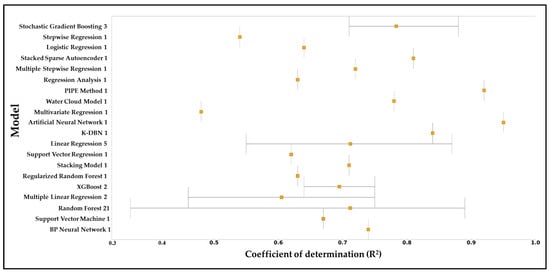
Figure 14.
Graph showing spaceborne regression model-based accuracy assessment analysis (the orange box represents the mean R2 value, and the horizontal lines show the minimum to maximum R2 values).
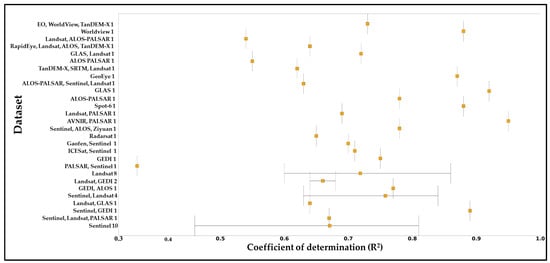
Figure 15.
Graph showing spaceborne dataset-based accuracy assessment analysis (the orange box represents the mean R2 value, and the horizontal lines show the minimum to maximum R2 values).
The error bar plot of R2 and the spaceborne datasets used is shown in Figure 15. It shows that Sentinel (10) was the most utilized imagery in studies with a reasonable number for analysis (Sentinel-2 (6), Sentinel-1 and 2 (4)), followed by Landsat (8) (Landsat-5 (3), Landsat-8 (3), Landsat-5, 7, and 8 (1), and Landsat-7 and 8 (1)). The highest number of studies utilizing Sentinel imagery and integrating it with other datasets was in China (14). Although not well explored, another promising integration framework for the spaceborne datasets of AVNIR, PALSAR, GLAS, Sentinel-1 and 2, and Spaceborne LiDAR (GEDI) resulted in an R2 of (0.95, 0.92. 0.89) [,,].
3.3.2. Airborne Analysis
An accuracy assessment of the airborne platform datasets and a regression model grounded on the article’s coefficient of determination (R2) was carried out for the datasets. Thirteen articles [,,,,,,,,,,,,] were employed for further analysis, as they had R2 values among the total classified articles (22). The error bar plot of R2 and the regression models used in Figure 16 showed that stepwise regression was the only model with two articles for analysis. The highest numbers of studies were conducted in the USA (4) and China (4).
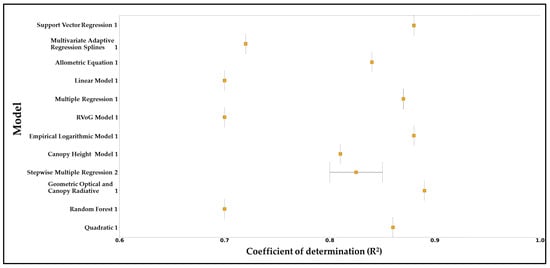
Figure 16.
Graph showing airborne regression model-based accuracy assessment analysis (the orange box represents the mean R2 value, and the horizontal lines show the minimum to maximum R2 values).
Ni-Meister W. et al. [] employed LVIS and airborne LiDAR datasets with geometric optical and canopy radiative models with parameters (tree height, stem diameter, vegetation density, leaf and background reflectivity coefficient ratio, biomass indices). They achieved an R2 of 0.89 for temperate deciduous and conifer forests in the USA. Liu X. et al. [] employed airborne LiDAR using an empirical logarithmic model with parameters (covariance matrix) and achieved an R2 of 0.88 for tropical forests in Gabon. Meng S. et al. [] employed airborne LiDAR and aerial imagery data with a support vector regression model along with parameters (wavelength, pulse length, sampling interval, sensor size, pulse firing rate, sensor size, and dimensions, r-spectrum, wavenumber). They achieved an R2 of 0.88 for broadleaf and conifer forests in China. Cao L. et al. [] achieved an R2 of 0.87 employing airborne LiDAR data using a multiple regression model with parameters (percentile heights h25–h95, height variation) for Moso Bamboo Forest in China. Ramachandran N. et al. [] utilized a quadratic model to achieve an R2 of 0.86 employing airborne SAR and LiDAR datasets with parameters (backscattered power, FHandQ, HV) for moist tropical forests in French Guiana. Torre-Tojal L. et al. [] achieved an R2 of 0.7 employing airborne LiDAR using a random forest model with parameters (height metrics (Elev P95, P99, P90)) for pine forests in Spain. Liao Z. et al. [] achieved an R2 of 0.7 employing airborne SAR and airborne LiDAR datasets with the RVoG model and parameters (volume backscatter from the forest canopy) for tropical rainforest in French Guiana. De Almeida C. et al. [] achieved an R2 of 0.70 employing airborne LiDAR and hyperspectral data using a linear model with ridge regularization and parameters (upper canopy cover and height percentiles, NIR, SWIR) for the Amazon Forest in Brazil. The error bar plot of R2 and the airborne platform datasets used is shown in Figure 17. Airborne LiDAR was the most utilized dataset in studies with a reasonable number (6) for analysis. Most airborne and UAV LiDAR studies were conducted in China (2). Another promising framework was integrating airborne LiDAR and aerial imagery [].

Figure 17.
Graph showing airborne datasets-based accuracy assessment analysis (the orange box represents the mean R2 value, and the horizontal lines show the minimum to maximum R2 values).
3.3.3. Space- and Airborne Analysis
An accuracy assessment of the space- and airborne platform datasets was carried out, and a regression model grounded on the article’s coefficient of determination (R2) was used. Fourteen articles [,,,,,,,,,,,,,] were employed for further analysis, as they had R2 values among the total classified articles (22). The error bar plot of R2 and the regression models used, shown in Figure 18, showed that random forest was the most used model, with five articles for analysis, followed by linear regression (4). The highest numbers of studies were conducted in the USA (7) and China (1).
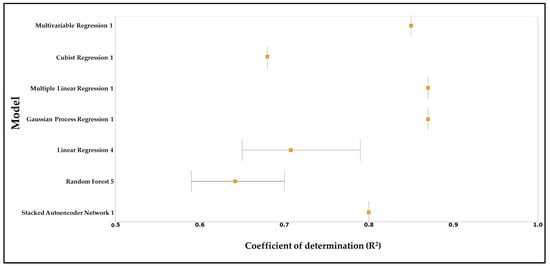
Figure 18.
Graph showing spaceborne–airborne regression model-based accuracy assessment analysis (the orange box represents the mean R2 value, and the horizontal lines show the minimum to maximum R2 values).
Qi W. et al. [] employed GEDI, TDX, and ALS datasets with multiple linear models with parameters (TDX height) and achieved an R2 of 0.87 for mixed temperate forests in the USA. Cooper S. et al. [] employed Landsat-7 and AVIRIS datasets with Gaussian process regression with parameters (combined EnMAP and Landsat texture signatures). They achieved an R2 of 0.87 for conifer and deciduous forests in the USA. Zhang Z. et al. [] employed Landsat-5, PRISM, and UAVSAR datasets with multivariate regression models with parameters (backscatter from track and canopy height). They achieved an R2 of 0.85 for boreal and temperate forests in the USA. Narine L. et al. [] employed ALS and ICESat-2 datasets with linear regression models with parameters (mean height, height bin, PCL-derived 10th percentiles, and canopy cover). They achieved an R2 of 0.79 for pine forests in the USA. Zald H. et al. [] employed PRISM and PALSAR imagery with a random forest model with parameters (NDVI, NDWI, Chlorophyll-VI). They achieved an R2 of 0.69 for pine and coniferous forests in Germany. Woodcock C. et al. [] employed Sentinel-1, Landsat-8, and NAIP datasets with random forest models with parameters (NDVI, EVI, VV, VH, brightness, greenness, wetness, heights 95, 85, 75, 50 percentile, image texture, texture ratio). They achieved an R2 of 0.63 for pine forest in the USA. Trung H. Nguyen et al. [] employed Landsat-TM/ETM and airborne LiDAR datasets with random forest with parameters (NBR, TCA, TCG, TCW, elevation, slope, stem density, basal area) and achieved a lower R2 of 0.59 and mean R2 of 0.56 for the boreal coniferous forest in Australia.
The error bar plot of R2 and the space- and airborne datasets used showed that Landsat-5, 7, and 8 and airborne LiDAR (3) were the most utilized imagery in studies for analysis, followed by GEDI, TDX, ICESat-2, and ALS with the lowest numbers (2), as shown in Figure 19. The highest number of studies with airborne LiDAR, ALS, Sentinel, GEDI, ICESat-2, TanDEM-X, and Landsat datasets were conducted in the USA (7). Another promising integration framework employed LiDAR (GEDI), ALX, and TDX and achieved an R2 of 0.87 [].
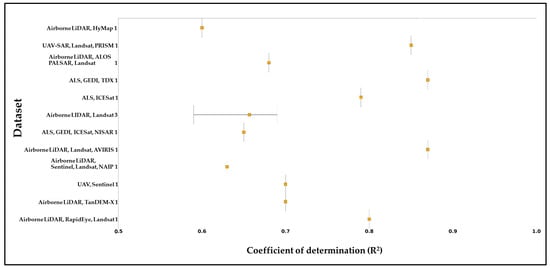
Figure 19.
Graph showing space- and airborne-based accuracy assessment analysis (the orange box represents the mean R2 value, and the horizontal lines show the minimum to maximum R2 values).
Summarized information compiled regarding the area, data source, research highlights, and accuracy of the main articles in all three categories (with respect to the highest coefficient of determination (R2) in that category) is shown in Table 2. It provides details on the most commonly used data sources, along with the parameters used and their accuracy in one location. It also serves to highlight the effectiveness of multi-platform integration approaches in forest AGB estimation, which was the main objective of this SLR. Table 2 also provides useful insights and is aligned with the error bar plots, which provide information regarding datasets and regression models employed, as shown in Figure 14, Figure 15, Figure 16, Figure 17, Figure 18 and Figure 19.

Table 2.
Summarized information on the main articles in all three categories.
3.4. Remote Sensing Platform Datasets in Forest Biome
The information extracted from the selected articles included forest types, survey data, and forest biome information. The forest types were further grouped by forest biome to understand their relation with remote sensing datasets. The forest biome vocabulary was drawn from the article [], which provides useful information about utilizing remote sensing datasets concerning the forest biome, as shown in Figure 20, Figure 21 and Figure 22. It gives an overview of platform-wise dataset segregation within the forest biome. It provides insights for researchers to decide which kinds of datasets would be better to select for accurately estimating forest AGB biomass, along with machine learning models and field data concerning forest biome. The analysis showed that most studies carried out utilizing spaceborne datasets were most frequently conducted for temperate broadleaf and mixed forests (9), airborne datasets were used most for tropical rain forests (5), and space- and airborne datasets were used most for temperate coniferous forests (9). Information regarding the reference, study area, survey data, forest type, and forest biome for each of the selected articles (98) is attached as Appendix A, Appendix B and Appendix C.
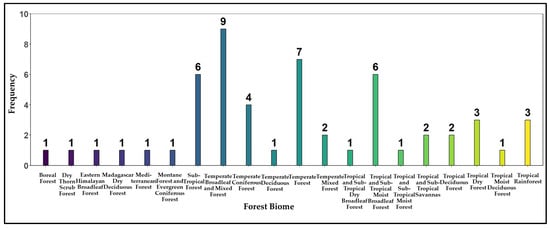
Figure 20.
Utilization of spaceborne platform datasets by forest biome.
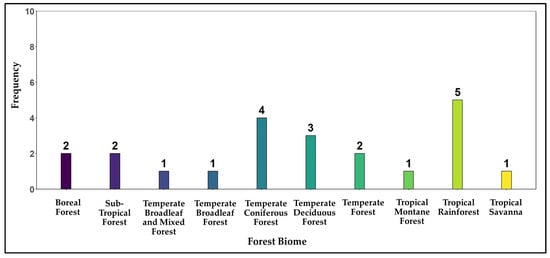
Figure 21.
Utilization of airborne platform datasets by forest biome.

Figure 22.
Utilization of space- and airborne platform datasets by forest biome.
4. Discussion
4.1. Discussion
Estimating forest aboveground biomass (AGB) with multiple remote sensing datasets is crucial for determining carbon density and stock, supporting and contributing to global carbon neutrality, and sustainable forest management initiatives. Previous studies have attempted to review various remote sensing datasets and integration workflows for forest biomass estimation [,,,,]. However, these reviews have yet to synthesize platform-wise synergetic integration approaches to map and estimate forest AGB.
This paper reviews the outcomes and highlights the novelty and effectiveness of various approaches using diverse remote sensing platform datasets, machine learning models, and parameters for forest AGB mapping and estimation. This SLR categorized multi-source remote sensing datasets into three categories and revealed that every category efficiently contributes to forest AGB estimation using field data and machine learning regression models. This review analysis highlighted the most utilized datasets (Sentinel, Landsat, airborne LiDAR, and GEDI) among the remote sensing datasets and their integration approaches. Many machine learning approaches were utilized in the selected articles, but that random forest was the preferred regression model was evident. It was also linked with co-citation analysis regarding the selected articles’ keywords and titles, which supports the reliability of our review criteria process and validates the significance of our research objectives. This review also identified important parameters across various remote sensing datasets, further strengthening the novelty of our approach and highlighting the multi-dimensional nature of AGB estimation. Integrating AVNIR-2 and the PALSAR dataset using an artificial neural network shows the innovative techniques employed to reduce validation errors in forest estimation, yielding a virtuous R2 value of 0.95 []. Similarly, Sentinel-1 and 2, spaceborne LiDAR (GEDI), TanDEM-X, and InSAR, in combination with a random forest model and TDX height model, demonstrate the efficacy of spaceborne datasets and ensemble learning approaches in achieving accurate AGB estimations [,]. This review also highlighted information about the various remote sensing platform datasets selected for forest biomes and revealed which datasets produce good results. Spaceborne instruments were primarily utilized in studies because of their wide availability and their ability to capture large-scale changes over time. They also offer a cost-efficient solution for continuous monitoring of forest environments. Another factor contributing to the frequency of spaceborne studies is the technological advances in satellite sensors in the last decade, such as Sentinel-2, Landsat-9, and GEDI, which have significantly enhanced their spatial, spectral, and structural information for more detailed and accurate forest AGB estimation. These are promising remote sensing datasets to integrate, as they help improve the efficiency of AGB modeling approaches and develop new approaches to reduce uncertainties and errors in forest biomass estimation.
4.2. Uncertainty in Forest AGB Estimation
To date, extensive global research has been conducted on increasingly reliable forest aboveground biomass estimation methods using remote sensing datasets and their integration approaches [,,,]. The accuracy of those approaches has been a reason for concern because these assessments must be carried out precisely to combat global warming and reach the global carbon emission neutrality targets effectively []. The accuracy of those methodologies has been something to frown upon. Several potential errors may overestimate or underestimate the AGB levels in the forest. Generally, stand structure, machine learning models, sample plot survey data, and remote sensing datasets add to these uncertainties [,,,]. However, the Sentinel-1A C-band cannot aid as an active predictor due to optical saturation error due to dense canopies and relatively lower penetration ability []. GEDI requires adjustment for multifaceted topography to confirm alignment with ground location, and due to its geolocation error, it overestimates forest AGB [,]. Using a random forest model does not include spatial patterns during modeling and may lead to spatial mismatch errors []. Many other uncertainties within the datasets may be attributed to sensor spatial resolution, sampling error, errors in allometric equations, and prediction model-associated errors []. These errors have resulted in uncertainties after the upscaling of field plot data and the unavailability of site-specific allometric equations in the estimated AGB product []. The errors of height variations in estimating forest AGB can result from the different growing stages of a single species []. Sunlight may also be a significant factor in identifying species configuration and extracting tree height and DBH using a LiDAR sensor in a dense forest canopy []. The LiDAR-derived AGB is uncertain when used as reference data instead of LiDAR field or plot data []. Quantifying and reducing uncertainties in the estimation remains a significant challenge. Seeing the diverse sources of uncertainties, it is essential to comprehensively compute the errors to reduce their effect on estimation accuracy. This offers a meaningful way forward for forthcoming research on reducing uncertainties and improving estimation accuracy. Furthermore, the accuracy of the estimation of forest AGB could be enhanced by using remote sensing dataset integration approaches, customized machine learning models, parameters, and field data insights.
4.3. Limitations
This systematic literature review provides a valuable overview of integration approaches combining remote sensing datasets with regression models for forest aboveground biomass estimation. Notably, this review features some limitations that can be addressed in future research. The scope of the present study also does not include analyses of forest characteristics (structures, species compositions, homogeneity, or heterogeneity). As stated above, analyzing forest characteristics may allow for tailored conservation strategies, promoting biodiversity and ecosystem resilience. Similarly, the scale of forest coverage has also not been analyzed in the present study. Changes in scale may increase or subsume complexity and detail and, therefore, determine the tools and techniques used for AGB estimation. Furthermore, the present study does not provide a detailed insight into forest AGB uncertainties and errors. Further detailed analysis of the uncertainties of data acquisition techniques and AGB modeling would be of interest for further refining remote sensing techniques, calibration models, and statistical approaches. This, in turn, would help understand and reduce the uncertainty in carbon stock assessments essential for global climate change mitigation initiatives.
4.4. Future Research Scope and Recommendations
Future research directions are suggested, along with knowledge gaps, for researchers from the analysis of this SLR based on the use of integrated remote sensing datasets to expand the scope and accuracy of forest AGB estimation. During this SLR, it was identified that there needs to be more consistent research to highlight the remote sensing dataset’s accuracy. Repeated research with integrated datasets using various regression models with different study areas will help improve the accuracy of AGB estimation. Integrating more parameters (satellite-derived independent variables, field plots, field inventory) will help link various integrated remote sensing datasets. This information will help to improve model validation and scope for reliable estimation workflows. Ground data validation should be the crucial approach in spaceborne LiDAR (GEDI, ICESat). With the help of ground validation, the uncertainty equation development should respond and help reduce the overall uncertainties in forest AGB estimates. Integrating frameworks with field inventory and plot datasets will provide different AGB estimates for study areas, forest types, and regions. These frameworks should also help capture forest changes over time but are crucial in enhancing machine learning model accuracies for AGB estimations. Technological advances like machine and deep learning can improve regression models. This, however, is a requirement to retrieve datasets and ground information for model training.
Additionally, future studies must prioritize the development of uncertainty equations for spaceborne LiDAR datasets like GEDI, which is crucial for refining AGB estimation approaches. In the future, initiatives such as the ESA’s BIOMASS mission, NASA–ISRO SAR (NISAR) missions, and the continuity of GEDI datasets hold the potential for enriching remote sensing datasets and emphasizing the course toward more effective monitoring and aligning with global objectives such as carbon neutrality under initiatives like REDD+ and the Paris Agreement.
5. Conclusions
This systematic literature review provides a comprehensive review of forest AGB estimation and shows the efficiency of integrating spaceborne and airborne datasets that align with the objectives. It can be concluded from the results of the SLR that integrating these datasets emerges as a dynamic strategy to improve biomass estimation and mapping, combining the diverse capabilities of spaceborne and airborne platforms. Considering the heterogeneity of forest environments, it is difficult to declare one specific remote sensing dataset and regression model as the best among others. However, methodologies like the random forest regression model demonstrated significant utility, particularly in regions like China. The limited number of studies in this field indicates a research gap, needing further investigation into synergistic integration approaches to enhance accuracy and reliability in AGB estimation. The approaches based on integrating Sentinel, Landsat, GEDI, and Airborne LiDAR datasets, along with a random forest regression model, may be strongly recommended to address this gap. These approaches mitigate uncertainties and support informed decision-making in forest ecosystem management.
Uncertainty in forest AGB estimation remains a critical challenge due to potential errors in remote sensing datasets, sample plot data, geo-location inaccuracies, and machine learning models. Addressing these uncertainties through integrated datasets and advanced modeling techniques is essential for improving estimation accuracy and supporting global climate goals. Future research should prioritize integrating diverse remote sensing datasets with robust ground validation to enhance AGB estimates further. Leveraging the advances in machine learning and developing uncertainty equations for spaceborne LiDAR, along with initiatives like the ESA’s BIOMASS and the NASA–ISRO SAR missions, is crucial. These steps will enrich data quality, align with global environmental goals, and contribute to sustainable forest management practices.
Author Contributions
Conceptualization, M.N.K. and Y.T.; methodology, M.N.K. and Y.T.; formal analysis, M.N.K.; investigation, M.N.K. and Y.T; resources, Y.T.; data curation, M.N.K.; writing—original draft preparation, M.N.K.; writing—review and editing, Y.T., A.A.G., S.A. and J.W.; visualization, M.N.K.; funding acquisition, Y.T. All authors have read and agreed to the published version of the manuscript.
Funding
This work was supported by the Sanxia Follow-up Project “The study on carbon neutrality benefits and contribution accounting of Three Gorges Reservoir” under Grant No. “102126222020270019081”.
Data Availability Statement
The manuscript includes all the relevant data (screened articles) as references and graphs.
Acknowledgments
The authors would like to acknowledge Maryam and Zoya Khan constant support during the development of this manuscript. Moreover, we thank Chen and the CiteSpace development team for making open-source software available for scientometric analysis and thorough visualization regarding the study’s interest. We are grateful to Muhammad Imran and M. Kamran Lodhi for reviewing this manuscript and for the anonymous reviewer’s helpful comments.
Conflicts of Interest
The authors declare no conflicts of interest.
Abbreviations
| Sr # | Abb | Word/Phrase |
| 1 | AGB | Aboveground Biomass |
| 2 | SLR | Systematic Literature Review |
| 3 | PRISMA | Preferred Reporting Items for Systematic Reviews and Meta-Analysis |
| 4 | WoS | Web of Science |
| 5 | nRMSE | Normalized Root Mean Square Error |
| 6 | R2 | Coefficient of Determination |
| 7 | GLAS | Geoscience Laser Altimeter System |
| 8 | GEDI | Global Ecosystem Dynamics Investigation |
| 9 | LiDAR | Light Detection and Ranging |
| 10 | UAV | Uncrewed Aerial Vehicle |
| 11 | RVoG | Randomly Orientated Volume Layer Over the Ground Surface |
| 12 | FVC | Fraction of Vegetation Cover |
| 13 | FAPAR | Fraction of Absorbed Photosynthetically Active Radiation |
| 14 | CAB | Chlorophyll Content in the Leaf |
| 15 | CWC | Canopy Water Content |
| 16 | SR | Simple Ratio Vegetation Index |
| 17 | NDVI | Normalized-Difference Vegetation Index |
| 18 | NDVI.RE | Transformed Normalized-Difference Vegetation Index |
| 19 | EVI | Enhanced Vegetation Index |
| 20 | TVI.RE | Renormalized Transformed Vegetation Index |
| 21 | IPVI.RE | Renormalized Infrared Percentage Vegetation Index |
| 22 | RDVI.RE | Renormalized Difference Vegetation Index |
| 23 | NDVIc | Corrected Normalized-Difference Vegetation Index |
| 24 | NDWI | Normalized Difference Water Index |
Appendix A

Table A1.
Spaceborne Dataset Articles.
Table A1.
Spaceborne Dataset Articles.
| Spaceborne Dataset Articles | |||||
|---|---|---|---|---|---|
| Reference | Study Area | Data Source | Survey Data | Forest Type | Forest Biome |
| [] | Caninde de Sao Francisco, Brazil | Sentinel-2 | 40 Plots (30 m × 30 m) | Dry Forest | Dry Thorn Scrub Forest |
| [] | Shanxia Forest, Jiangxi Province, China | Sentinel-2, Sentinel-1 | 50 Plots (30 m × 30 m) | Sub-Tropical Forest | Sub-Tropical Forest |
| [] | Dali City, Yunnan Province, China | Sentinel-2, Landsat-5-7-8, PALSAR | 2000 Plots (01–0.2 ha) in 2007 and 2016, 78 Plots (28.5 × 28.5 m) 2011 | Evergreen Coniferous Forests | Montane Forest and Evergreen Coniferous Forests |
| [] | Zhangwu, Liaoning Province, China | Sentinel-1 and 2, GEDI-L2A | 48 Circular Plots (diameter of 30 m) | Temperate Planted Forest | Temperate Forest |
| [] | Abbottabad, Pakistan | Sentinel-2 | 60 Plots of Circular Shape (area of 0.1 ha and 17.84 m radius) | Moist Temperate Forests | Temperate Forest |
| [] | Amazon, Brazil | Landsat, GLAS | GLAS footprints in 283 standardized plots (40 × 40 m) | Tropical Rainforest | Tropical Rainforest |
| [] | Raghavendra Nagar, Sileru Region, Northern Andhra Pradesh, India | Sentinel-2 | 60 Plots with 0.1 ha (31.63 m × 31.63 m) | Semi-Evergreen, Moist, and Dry Deciduous Forest | Tropical Deciduous Forest |
| [] | Yunnan, China | Sentinel-2, Landsat-8 | FIA Plots 1776 (25.8 m × 25.8 m) | Sub-Tropical Evergreen Broadleaf and Temperate Coniferous Forests | Sub-Tropical Forest |
| [] | Magdalena River Valley, Tolima, Colombia | Sentinel-2, Sentinel-1 | 4 Plots (100 m × 100 m with 25 subplots of 20 m × 20 m) | Dry Tropical Forest | Tropical Dry Forest |
| [] | Lopé National Park, Gabon | LVIS, GEDI-L4A and L2A, TanDEM-X | LVIS Height as a Reference | Tropical Moist Deciduous Forest | Tropical Rainforest |
| [] | Terai Central Forest Division (TCFD) in Nainital, India | GEDI-L2A, ALOS-2 | 25 Plots | Deciduous Forest | Tropical Deciduous Forest |
| [] | Mabalane, Mozambique | Landsat-5 and 8, GEDI-L4A | Canopy Structure Extracted from GEDI Data | Tropical Dry Forest | Tropical Dry Forest |
| [] | Southern Western Australia, Australia | Landsat-5, 7, and 8 | 10,304 Plots | Broadleaf Evergreen Forests | Mediterranean Forest |
| [] | Ibraki, Japan | PALSAR, Sentinel-2 | 40 Plots (0.04 ha) (for ground-based calibration of the airborne LiDAR data) | Cypress and Cedar Forest | Temperate Broadleaf and Mixed Forest |
| [] | The Terai Central Forest Division, Uttarakhand, India | GEDI-L2A | 92 Plots (31.6 m × 31.6 m (0.1 hectares)) | Shisham, Acacia, and Kadukkai Forest | Tropical Dry Forest |
| [] | Saihanba Mechanical Forest, China | ICESat-2, Sentinel-2 | 5396 Plots of Forest Management Inventory (FMI) | Larch, Pine, and Birch Forest | Temperate Coniferous Forest |
| [] | Shangri-La, Yunnan Province, China | Sentinel-1 and 2, Landsat-8, ICESat-2 | 1193 Trees Measured, with 2015 Forest Survey Data | Pinus, Picea, and Quercus Forest | Temperate Broadleaf and Mixed Forest |
| [] | Jiayi, Pingjiang County, Yueyang City, Hunan Province, China | Sentinel-2 | 1236 Plots (20 m × 20 m) | Evergreen Broadleaf Forest | Sub-Tropical Forest |
| [] | Dabie Mountains, China | Gaofen-1, Sentinel-1 | 326 Plots (16 m × 16 m) | Coniferous and Broadleaf Forest | Temperate Mixed Forest |
| [] | Dabie Mountains, China | Landsat-8 | 681 Plots (0.067 ha in size) | Coniferous and Broadleaf Forest | Temperate Mixed Forest |
| [] | Malhan Forest Range, Dehradun, India | Radarsat-2 | 38 Plots (0.1 ha) | Mixed Deciduous Forest | Tropical and Sub-Tropical Moist Broadleaf Forest |
| [] | Wangyedian Forest Farm, China | Landsat-8 | 81 Plots (25 m × 25 m) | Coniferous, Pine, and Larch Forest | Temperate Coniferous Forest |
| [] | Guizhou Province, China | Sentinel-2, Landsat-8 | 1992 Plots (0.067 ha) | Sub-Tropical Evergreen Broadleaf Forest | Sub-Tropical Forest |
| [] | Wangyedian Forest Farm, China | Sentinel-2, ALOS, Ziyuan-3 | 67 Plots (25 m × 25 m) | Coniferous, Pine, and Larch Forest | Temperate Coniferous Forest |
| [] | Bears Ears National Monument (BENM), Utah, USA | Landsat-8; GEDI-L1A, 2A, and 2B | 65 Circular Plots (59 plots with 15 m radii and 6 plots with 18 m radii) | Pine and Juniper Forest | Temperate Coniferous Forest |
| [] | Minas Gerais State, Brazil | AVNIR-2, PALSAR | 206 Plots (341 m2) | Eucalyptus Forest | Temperate Broadleaf and Mixed Forest |
| [] | Chenzhou City, Hunnan, China | Landsat-8, Sentinel-1 | 367 Plots (25.82 m × 25.82 m) (0.0667 ha) | Sub-Tropical Evergreen Forest | Sub-Tropical Forest |
| [] | Kermanshah, Iran | Sentinel-1, Sentinal-2 | 124 Plots (30 m × 30 m) | Oak Forest | Temperate Deciduous Forest |
| [] | Tuscany, Italy | Landsat-5, PALSAR | 1350 Plots | Broadleaf Forest | Temperate Broadleaf and Mixed Forest |
| [] | Changbai Mountains, Jilin Province, China | ALOS PALSAR-2, Sentinel-2, Sentinel-1 | 1167 Plots (10 m × 10 m) | Deciduous Broadleaf Forest | Temperate Broadleaf and Mixed Forest |
| [] | KwaZulu-Natal, South Africa | Spot-6 | 90 Plots (35 m × 35 m) | Tropical Dry Forest | Tropical and Sub-Tropical Dry Broadleaf Forest |
| [] | Yichun, China | Sentinel-2, Sentinel-1 | 44 Plots (20 m × 20 m) | Coniferous and Broadleaf Forest | Temperate Mixed Forest |
| [] | Yok Don National Park, Vietnam | Sentinel-2 | 58 Plots (25 m × 25 m for deciduous broadleaf forest and 33.3 m × 30 m for evergreen broadleaf forest) | Evergreen and Deciduous Broadleaf Forest | Tropical and Sub-Tropical Moist Broadleaf Forest |
| [] | Thuan Chau, Son La Province, Vietnam | Sentinel-2 | 240 Plots (30 m × 33.3 m) (0.1 ha) | Evergreen Broadleaf and Limestone Forest | Tropical and Sub-Tropical Moist Broadleaf Forest |
| [] | Minas Gerais State, Brazil | Landsat-5 | 188 Plots (10 m × 100 m) | Semi-Deciduous Forest | Tropical and Sub-Tropical Moist Forest |
| [] | Dudhwa National Park, India | ALOS-PALSAR | 170 Plots (0.1 ha size) | Semi-Evergreen and Moist Deciduous Forest | Tropical and Sub-Tropical Moist Broadleaf Forest |
| [] | Xishuangbanna, Yunnan, China | GLAS | 26 Plots (radius of 7.5 m, or 15 m radius plot if slope > 15°) | Tropical Mountain Rainforest | Tropical Rainforest |
| [] | West Kameng and Tawang Districts of Arunachal Prades, India | ALOS-PALSAR, Sentinel-1, Landsat-TM | 57 Different Belt Transects (size of transects 500 × 10 m (0.5 ha), quadrat size (10 m × 10 m)) | Eastern Himalayan Forests | Eastern Himalayan Broadleaf Forest |
| [] | Katerniaghat Wildlife Sanctuary, India | Sentinel-2, Sentinel-1 | 70 Plots (20 m × 20 m) (0.04 ha area) | S. Robusta Forest | Tropical Moist Deciduous Forest |
| [] | Mukuvisi Woodland, Harare, Zimbabwe | GeoEye-1 | 41 Tree Canopy Information | Deciduous Dry Miombo Forest | Tropical and Sub-Tropical Savannas |
| [] | Quebec City, Canada | TanDEM-X, SRTM, Landsat-8 | 200 Circular Plots (radius of 11.28 m) | Boreal Forest | Boreal Forest |
| [] | Cape St. Mary, Madagascar | ALOS PALSAR | 572 Plots (30 m radius with size of 0.28 ha in moist forest and 20 m radius with 0.13 ha size in dry or spiny forest) | Dry, Spiny, and Moist Forest | Madagascar Dry Deciduous Forest |
| [] | Himalayan Belt of Uttar Pradesh, India | ALOS PALSAR | 41 Plots (20 m × 20 m) | Tropical Deciduous Mixed Forest | Tropical and Sub-Tropical Moist Broadleaf Forest |
| [] | Changbai Mountain, China | GLAS, Landsat-5 | 58 Plots (7.5 m radius central plot located at the center of a GLAS footprint) | Evergreen Deciduous and Coniferous Forest | Temperate Broadleaf and Mixed Forest |
| [] | Northeast Conghua, Guangdong, China | Landsat-8, Sentinel-1 | 60 Plots (30 m × 30 m) | Coniferous and Broadleaf Mixed Forest | Temperate Mixed Forest |
| [] | San Rossore, Italy | ALOS-PALSAR | 60 Circular Plots (13 m radius plot, all trees with DBH of at least 9.5 cm) | Conifers and Deciduous Broadleaf Forest | Temperate Broadleaf and Mixed Forest |
| [] | Liwale District, Tanzania | RapidEye, Landsat-8, ALOS-PALSAR, TanDEM-X | 88 Circular Plots (15 m radius) | Miombo Forest | Tropical and Sub-Tropical Savannas |
| [] | Zhejiang Province, China | Landsat-5 TM, ALOS-PALSAR | 802 Plots (20 m × 20 m) | Sub-Tropical Evergreen Broadleaf Forest | Sub-Tropical Forest |
| [] | Pune, Raigarh, India | Landsat-5 | 162 Plots (31.5 m × 31.5 m) | Moist Deciduous Forest | Tropical and Sub-Tropical Moist Broadleaf Forest |
| [] | Sappi Clan Forests, KwaZulu Natal, South Africa | Worldview-2 | 181 Plots (radius 10 m) | Eucalyptus and Pine Forest | Temperate Forest |
| [] | Kashmir Himalayas, India | Landsat-5 | 45 Plots (0.1 ha) | Himalayan Temperate Deciduous and Fir Forest | Temperate Broadleaf and Mixed Forest |
| [] | KwaZulu Natal Province, South Africa | Landsat-7 and 8 | 181 Plots (400 m radius circular plots, distributed systematically (100 m) within the stand) | Eucalyptus and Pine Forest | Temperate Forest |
| [] | KwaZulu Natal Province, South Africa | Landsat-8 | 181 Plots (10 m radius circular plots, distributed systematically (100 m) within the stand) | Eucalyptus and Pine Forest | Temperate Forest |
| [] | Karlsruhe, Germany | EO-1, WorldView-2, TanDEM-X | 303 Circular Plots (2 m, 3 m, 6 m, and 12 m radius) | European Temperate Forest | Temperate Broadleaf and Mixed Forest |
Appendix B

Table A2.
Airborne Dataset Articles.
Table A2.
Airborne Dataset Articles.
| Airborne Dataset Articles | |||||
|---|---|---|---|---|---|
| Reference | Study Area | Data Source | Survey Data | Forest Type | Forest Biome |
| [] | Jiangxi Nanfengmian National Reserve, China | UAV-LiDAR | 40 × 40 m Sample Plot | Sub-Tropical Evergreen Broadleaf Forest | Sub-Tropical Forest |
| [] | Paracou, French Guiana | Airborne LiDAR, Airborne SAR | 16 Plots (twelve 9 ha plots (300 m × 300 m) in 1984, three 9 ha plots (300 m × 300 m) in 1992, one 25 ha (500 m × 500 m) in 1992) | Moist Tropical Forest | Temperate Coniferous Forest |
| [] | Orozko, Spain | Airborne LiDAR | 55 Plots (area 0.2 ha) | Pine Forest | Temperate Forest |
| [] | Sierra Nevada, CA, USA | LVIS, Airborne LiDAR | 73 Plots (30–50 m, 25 m, 20 m) | Temperate Deciduous and Conifer Forest | Tropical Montane Forest |
| [] | Ulu Padas, Malaysia | Airborne LiDAR | 76 Plots in 2012 (30 × 30 m, except for logged forest plots (2 plots of 20 m × 20 m) and high AGB plot (1 plot of 50 m × 50 m)); 56 Plots in 2017 (30 × 30 m). | Tropical Montane Forest | Temperate Broadleaf and Mixed Forest |
| [] | Baima Snow Mountain National Nature Reserve, China | UAV RGB Imagery, UAV LiDAR | 34 Plots (30 × 30 m) | Conifer and Broadleaf Forest | Tropical Rainforest |
| [] | Gabon Lopé National Park, Gabon | Airborne SAR, Airborne LiDAR | 14 Plots (plot area 12.5 ha) | Tropical Forest | Temperate Deciduous Forests |
| [] | Paracou, Sinnamary, French Guiana | PolInSAR, Airborne LiDAR | 19 Plots of 6.25 ha (250 × 250 m2) | Tropical Rainforest | Temperate Deciduous Forests |
| [] | Jiangsu Province, China | Airborne LiDAR | 32 Circular Plots (20 × 20 m2) | Moso Bamboo Sub-Tropical Forest | Sub-Tropical Forest |
| [] | Amazon, Brazil | Airborne LiDAR, Airborne Hyper Spectral | FIA 132 Plots (116 plots of 0.25 ha and 16 plots of 0.16 ha) | Tropical Forest | Tropical Forest |
| [] | Tanana Inventory Unit, Alaska, USA | ALS | A—FIA data (94 field clusters included 366 (7.32 m radius) plots). B—The Department of Defense field dataset consisted of 160 FIA clusters incorporating 603 permanent plots of a 7.32 m radius. C—The BCEF included 59 clusters (226 plots), and the CPCRW dataset included 38 clusters (146 plots). | Boreal Forest | Temperate Deciduous Forest |
| [] | Moravian-Silesian Beskydy Mountains, Czech Republic | ALS-HS Data, Airborne LiDAR | 93 Plots in Circular Shape with an Area of 500 m2 (radius of 12.62 m) | Spruce, Beech, and Broadleaf Forest | Tropical Rainforest |
| [] | BCA (Bia), Dadieso Forest Reserve, Ghana | Airborne LiDAR | 40 plots (40 × 40 m) | Moist Evergreen and Semi-Deciduous Forest | Tropical Rainforest |
| [] | Águeda, Portugal | Airborne LiDAR | 40 Plots (400 m2) | Eucalyptus Forest | Temperate Broadleaf Forest |
| [] | Minnesota, USA | Airborne LiDAR | NFI 598 Plots (7.32 m radius circular subplots) | Fir and Spruce Forest | Tropical Savanna |
| [] | Liwale, Tanzania | Airborne LiDAR | 513 Plots (the distance between plot centers within a cluster was 250 m) | Miombo Forest | Tropical Rainforest |
| [] | Nouragues Ecological Research Station, French Guiana | Airborne LiDAR, Airborne SAR | A—2 plots at the Nouragues site (1000 × 100 m2, (400 × 300 m2). The 2 were subdivided into 100 × 100 m2 subplots, resulting in 22 study plots of 1 ha. Five additional plots were included, three of 1 ha (100 × 100 m2) and two 0.25 ha plots (50 × 50 m2). B—16 plots at the Sinnamary: 15 plots of (250 × 250 m2) (6.25 ha) and one plot of (500 × 500 m2) (25 ha). Subdivided large plots into 100 × 100 m2. This resulted in 85 field plot units for the Paracou site. | Moist Tropical Forest | Temperate Forest |
| [] | Liangshui National Reserve, Heilongjiang, China | Airborne LiDAR, Aerial Imagery | 74 Circular Plots (with a radius of 13.8 m) and 600 m2 Area | Broadleaf and Conifer Forest | Boreal Forest |
| [] | Stor-Elvdal in Hedmark County, Norway | ALS | NFI 145 Circular Plots 250 m2 Area | Spruce and Pine Forest | Boreal Forest |
| [] | Evo, Finland | ALS | 368 Circular Plots of Radius 9.77 m (300 m2). | Spruce and Pine Forest | Temperate Coniferous Forest |
| [] | USDA-FS Sagehen Creek Experimental Forest, California, USA | Airborne LiDAR | 80 Circular Plots of 12.6 m Radius (0.05 ha) | Conifer Forest | Temperate Coniferous Forest |
| [] | Swiss National Park, Switzerland | Airborne APEX | 35 Plots (30 × 30 m) | Pine and Larch Forest | Temperate Coniferous Forest |
Appendix C

Table A3.
Spaceborne—Airborne Dataset Articles.
Table A3.
Spaceborne—Airborne Dataset Articles.
| Spaceborne—Airborne Dataset Articles | |||||
|---|---|---|---|---|---|
| Reference | Study Area | Data Source | Survey Data | Forest Type | Forest Biome |
| [] | Terai Arc Landscape, Nepal | Airborne LiDAR, RapidEye, Landsat-5 | 632 Plots (radius 12.5 m) | Continuous Dense Forest (Sal, Chir Pine, Karmal, Marking Nut) | Tropical and Sub-Tropical Moist Broadleaf Forest |
| [] | Teshio Experimental Forest, Hokkaido, Japan | Airborne LiDAR, TanDEM-X | LiDAR-derived AGB as Reference AGB Data | Deciduous Broadleaf and Coniferous Forest | Temperate Broadleaf and Mixed Forest |
| [] | China | UAV-LiDAR, Sentinel-2 | 1370 Plots (20 m × 20 m, except forty circular plots with a radius of 15 m and thirty 30 m × 30 m square plots in Site 3) | Temperate Needleleaf–Broadleaf, Temperate Coniferous, and Sub-Tropical Evergreen Broadleaf Forest | Temperate Broadleaf, Coniferous, and Sub-Tropical Broadleaf Forest |
| [] | North Carolina, USA | Airborne LiDAR, Sentinel-1, Landsat-8, NAIP | FIA 227 Plots (each plot consisted of four 7.3 m radius subplots) | Coniferous Forest | Temperate Coniferous Forest |
| [] | Sierra National Forest, CA, USA | ALS, Sentinel-1 | Plot Inventory Data (10.1109/JSTARS.2018.2851606) | Ponderosa Pine and Incense Cedar Forest | Temperate Coniferous Forest |
| [] | Sonoma County, California, USA | Airborne LiDAR, Landsat-7, AVIRIS | 166 Plots | Conifer and Deciduous Forest | Temperate Mixed Forest |
| [] | Sonoma County, California, USA | ALS, GEDI, ICESat-2, NISAR | ALS Reference Map | Conifers, Deciduous, and Mixed Forests | Temperate Mixed Forest |
| [] | Khao Yai National Park, Thailand | Airborne LiDAR, Landsat-8, Sentinel-2, WorldView-3 | 70 Field Plots (0.5 ha) | Semi-Evergreen and Deciduous Forests | Temperate Coniferous Forest |
| [] | Sonoma County, California, USA | ALS, GEDI-L4A, ICESat-2, NISAR, UAV-SAR | ALS Reference Map | Conifer Forest | Temperate Coniferous Forest |
| [] | Victoria, Australia | Airborne LiDAR, Landsat | FIA 633 Circular Plots (0.4 ha) | Sclerophyll Forests | Temperate Forest |
| [] | Mondah, Gabon | UAV-SAR, PALSAR-2, GEDI | LVIS-derived AGB Reference Map | Tropical Forest | Tropical Rainforest |
| [] | Walker County, Texas, USA | ALS, ICESat-2 | Ground-measured tree heights and crown diameters from a total of 705 pine trees and 603 deciduous trees from field inventories were used to obtain TreeVaW coefficients. | Pine Forest | Temperate Coniferous Forest |
| [] | LaRioja, Spain | ALS, Landsat | 150 SNFI Plots (25 m radius plot) | Scots Pine Forest | Temperate Coniferous Forest |
| [] | White Mountain National Forest in New Hampshire, USA | ALS, InSAR, GEDI, TDX | 16 Plots (25 m × 25 m), 12 Plots (1 ha) | Mixed Temperate Forest | Temperate Broadleaf and Mixed Forest |
| [] | Yucatan Peninsula, Mexico | Airborne LiDAR, ALOS PALSAR, Landsat-5 and 7 | 312 Plots (1 ha) | Deciduous and Conifer Forest | Tropical and Sub-Tropical Moist Broadleaf Forest |
| [] | The Tanana Valley State Forest, USA | Airborne LiDAR, Landsat-8 | FIA Plots 827 (7.3 m radius) | Boreal Forest | Boreal Forest |
| [] | Howland, USA | UAV-SAR, Landsat-5, PRISM | A—24 plots (50 m × 200 m per plot, each plot being divided into sixteen 25 m × 25 m subplots) in 2009. B—10 plots (50 m × 100 m) and 1 plot (50 m × 50 m) in 2010 | Boreal and Temperate Forest | Mixed Forest |
| [] | Saskatchewan, Canada | Airborne LIDAR, Landsat-5 | 4340 LiDAR Plots | Spruce and Pine Forest | Boreal Forest |
| [] | Hedmark County, Norway | Airborne LiDAR, Landsat-5 | 662 Plots (circular plots of 250 m2) | Spruce and Pine Forest | Boreal Forest |
| [] | San Carlos Apache Reservation, Arizona, USA | Airborne LiDAR, Landsat-8 | 39 Plots (30 m × 30 m) | Pine and Juniper Forest | Temperate Coniferous Forest |
| [] | Karlsruhe, Germany | Airborne LiDAR, HyMap | 297 Plots (2, 3, 6, and 12 m radii in 200 × 100 m grid) | Pine and Coniferous Forest | Temperate Coniferous Forest |
| [] | Hokkaido University, Japan | Aerial Photos, PRISM, PALSAR | 28 Forest Stands Ranging from 0.25 ha (50 m × 50 m) to 3 ha (200 m × 150 m) | Evergreen Needleleaf and Deciduous Broadleaf Forest | Temperate Coniferous Forest |
References
- Abbas, S.; Wong, M.S.; Wu, J.; Shahzad, N.; Muhammad Irteza, S. Approaches of Satellite Remote Sensing for the Assessment of Above-Ground Biomass across Tropical Forests: Pan-Tropical to National Scales. Remote Sens. 2020, 12, 3351. [Google Scholar] [CrossRef]
- Bordoloi, R.; Das, B.; Tripathi, O.P.; Sahoo, U.K.; Nath, A.J.; Deb, S.; Das, D.J.; Gupta, A.; Devi, N.B.; Charturvedi, S.S.; et al. Satellite Based Integrated Approaches to Modelling Spatial Carbon Stock and Carbon Sequestration Potential of Different Land Uses of Northeast India. Environ. Sustain. Indic. 2022, 13, 100166. [Google Scholar] [CrossRef]
- Sedano, F.; Lisboa, S.; Duncanson, L.; Ribeiro, N.; Sitoe, A.; Sahajpal, R.; Hurtt, G.; Tucker, C. Monitoring Intra and Inter Annual Dynamics of Forest Degradation from Charcoal Production in Southern Africa with Sentinel—2 Imagery. Int. J. Appl. Earth Obs. Geoinf. 2020, 92, 102184. [Google Scholar] [CrossRef]
- Xu, L.; Saatchi, S.S.; Yang, Y.; Yu, Y.; Pongratz, J.; Anthony Bloom, A.; Bowman, K.; Worden, J.; Liu, J.; Yin, Y.; et al. Changes in Global Terrestrial Live Biomass over the 21st Century. Sci. Adv. 2021, 7, eabe9829. [Google Scholar] [CrossRef] [PubMed]
- Feng, Y.; Zeng, Z.; Searchinger, T.D.; Ziegler, A.D.; Wu, J.; Wang, D.; He, X.; Elsen, P.R.; Ciais, P.; Xu, R.; et al. Doubling of Annual Forest Carbon Loss over the Tropics during the Early Twenty-First Century. Nat. Sustain. 2022, 5, 444–451. [Google Scholar] [CrossRef]
- Guo, Y.; Zhu, M.; Wu, Y.; Ni, J.; Liu, L.; Xu, Y. Estimating Forest Aboveground Biomass Combining Pléiades Satellite Imagery and Field Inventory Data in the Peak–Cluster Karst Region of Southwestern China. Forests 2023, 14, 1760. [Google Scholar] [CrossRef]
- Cai, Y.; Shi, Q.; Xu, X.; Liu, X. A Novel Approach towards Continuous Monitoring of Forest Change Dynamics in Fragmented Landscapes Using Time Series Landsat Imagery. Int. J. Appl. Earth Obs. Geoinf. 2023, 118, 103226. [Google Scholar] [CrossRef]
- Gyamfi-Ampadu, E.; Gebreslasie, M. Two Decades Progress on the Application of Remote Sensing for Monitoring Tropical and Sub-Tropical Natural Forests: A Review. Forests 2021, 12, 739. [Google Scholar] [CrossRef]
- Khan, M.R.; Khan, I.A.; Baig, M.H.A.; Liu, Z.-J.; Ashraf, M.I. Exploring the Potential of Sentinel-2A Satellite Data for Aboveground Biomass Estimation in Fragmented Himalayan Subtropical Pine Forest. J. Mt. Sci. 2020, 17, 2880–2896. [Google Scholar] [CrossRef]
- Arévalo, P.; Baccini, A.; Woodcock, C.E.; Olofsson, P.; Walker, W.S. Continuous Mapping of Aboveground Biomass Using Landsat Time Series. Remote Sens. Environ. 2023, 288, 113483. [Google Scholar] [CrossRef]
- Chen, H.; Qin, Z.; Zhai, D.-L.; Ou, G.; Li, X.; Zhao, G.; Fan, J.; Zhao, C.; Xu, H. Mapping Forest Aboveground Biomass with MODIS and Fengyun-3C VIRR Imageries in Yunnan Province, Southwest China Using Linear Regression, K-Nearest Neighbor and Random Forest. Remote Sens. 2022, 14, 5456. [Google Scholar] [CrossRef]
- Santoro, M.; Cartus, O.; Carvalhais, N.; Rozendaal, D.M.A.; Avitabile, V.; Araza, A.; De Bruin, S.; Herold, M.; Quegan, S.; Rodríguez-Veiga, P.; et al. The Global Forest Above-Ground Biomass Pool for 2010 Estimated from High-Resolution Satellite Observations. Earth Syst. Sci. Data 2021, 13, 3927–3950. [Google Scholar] [CrossRef]
- Schepaschenko, D.; Moltchanova, E.; Fedorov, S.; Karminov, V.; Ontikov, P.; Santoro, M.; See, L.; Kositsyn, V.; Shvidenko, A.; Romanovskaya, A.; et al. Russian Forest Sequesters Substantially More Carbon than Previously Reported. Sci. Rep. 2021, 11, 12825. [Google Scholar] [CrossRef] [PubMed]
- Ahmad, A.; Gilani, H.; Ahmad, S.R. Forest Aboveground Biomass Estimation and Mapping through High-Resolution Optical Satellite Imagery—A Literature Review. Forests 2021, 12, 914. [Google Scholar] [CrossRef]
- Shendryk, Y. Fusing GEDI with Earth Observation Data for Large Area Aboveground Biomass Mapping. Int. J. Appl. Earth Obs. Geoinf. 2022, 115, 103108. [Google Scholar] [CrossRef]
- Liang, M.; Duncanson, L.; Silva, J.A.; Sedano, F. Quantifying Aboveground Biomass Dynamics from Charcoal Degradation in Mozambique Using GEDI Lidar and Landsat. Remote Sens. Environ. 2023, 284, 113367. [Google Scholar] [CrossRef]
- Liao, Z.; Liu, X.; van Dijk, A.; Yue, C.; He, B. Continuous Woody Vegetation Biomass Estimation Based on Temporal Modeling of Landsat Data. Int. J. Appl. Earth Obs. Geoinf. 2022, 110, 102811. [Google Scholar] [CrossRef]
- D’Oliveira, M.V.N.; Figueiredo, E.O.; de Almeida, D.R.A.; Oliveira, L.C.; Silva, C.A.; Nelson, B.W.; da Cunha, R.M.; de Almeida Papa, D.; Stark, S.C.; Valbuena, R. Impacts of Selective Logging on Amazon Forest Canopy Structure and Biomass with a LiDAR and Photogrammetric Survey Sequence. For. Ecol. Manag. 2021, 500, 119648. [Google Scholar] [CrossRef]
- May, P.; McConville, K.S.; Moisen, G.G.; Bruening, J.; Dubayah, R. A Spatially Varying Model for Small Area Estimates of Biomass Density across the Contiguous United States. Remote Sens. Environ. 2023, 286, 113420. [Google Scholar] [CrossRef]
- Chen, L.; Ren, C.; Zhang, B.; Wang, Z.; Liu, M.; Man, W.; Liu, J. Improved Estimation of Forest Stand Volume by the Integration of GEDI LiDAR Data and Multi-Sensor Imagery in the Changbai Mountains Mixed Forests Ecoregion (CMMFE), Northeast China. Int. J. Appl. Earth Obs. Geoinf. 2021, 100, 102326. [Google Scholar] [CrossRef]
- Hoffr, R.; Teresa, M.; De, J.; Domingo, D.; Luis, A.; García-martín, A.; Revilla, S. Assessing GEDI-NASA System for Forest Fuels Classification Using Machine Learning Techniques. Int. J. Appl. Earth Obs. Geoinf. 2023, 116, 103175. [Google Scholar] [CrossRef]
- Duncanson, L.; Kellner, J.R.; Armston, J.; Dubayah, R.; Minor, D.M.; Hancock, S.; Healey, S.P.; Patterson, P.L.; Saarela, S.; Marselis, S.; et al. Aboveground Biomass Density Models for NASA’s Global Ecosystem Dynamics Investigation (GEDI) Lidar Mission. Remote Sens. Environ. 2022, 270, 112845. [Google Scholar] [CrossRef]
- Ochiai, O.; Poulter, B.; Seifert, F.M.; Ward, S.; Jarvis, I.; Whitcraft, A.; Sahajpal, R.; Gilliams, S.; Herold, M.; Carter, S.; et al. Toward a Roadmap for Space-Based Observations of the Land Sector for the UNFCCC Global Stocktake. iScience 2023, 26, 106489. [Google Scholar] [CrossRef] [PubMed]
- Chen, Q.; McRoberts, R.E.; Wang, C.; Radtke, P.J. Forest Aboveground Biomass Mapping and Estimation across Multiple Spatial Scales Using Model-Based Inference. Remote Sens. Environ. 2016, 184, 350–360. [Google Scholar] [CrossRef]
- Bilous, A.; Myroniuk, V.; Holiaka, D.; Bilous, S.; See, L.; Schepaschenko, D. Mapping Growing Stock Volume and Forest Live Biomass: A Case Study of the Polissya Region of Ukraine. Environ. Res. Lett. 2017, 12, 105001. [Google Scholar] [CrossRef]
- Chen, L.; Wang, Y.; Ren, C.; Zhang, B.; Wang, Z. Assessment of Multi-Wavelength SAR and Multispectral Instrument Data for Forest Aboveground Biomass Mapping Using Random Forest Kriging. For. Ecol. Manag. 2019, 447, 12–25. [Google Scholar] [CrossRef]
- Yang, H.; Ciais, P.; Wigneron, J.P.; Chave, J.; Cartus, O.; Chen, X.; Fan, L.; Green, J.K.; Huang, Y.; Joetzjer, E.; et al. Climatic and Biotic Factors Influencing Regional Declines and Recovery of Tropical Forest Biomass from the 2015/16 El Ni~no. Proc. Natl. Acad. Sci. USA 2022, 119, e2101388119. [Google Scholar] [CrossRef] [PubMed]
- Nguyen, T.H.; Jones, S.; Soto-Berelov, M.; Haywood, A.; Hislop, S. A Comparison of Imputation Approaches for Estimating Forest Biomass Using Landsat Time-Series and Inventory Data. Remote Sens. 2018, 10, 1825. [Google Scholar] [CrossRef]
- Rees, W.G.; Tomaney, J.; Tutubalina, O.; Zharko, V.; Bartalev, S. Estimation of Boreal Forest Growing Stock Volume in Russia from Sentinel-2 Msi and Land Cover Classification. Remote Sens. 2021, 13, 4483. [Google Scholar] [CrossRef]
- Turton, A.E.; Augustin, N.H.; Mitchard, E.T.A. Improving Estimates and Change Detection of Forest Above-Ground Biomass Using Statistical Methods. Remote Sens. 2022, 14, 4911. [Google Scholar] [CrossRef]
- Mutanga, O.; Masenyama, A.; Sibanda, M. Spectral Saturation in the Remote Sensing of High-Density Vegetation Traits: A Systematic Review of Progress, Challenges, and Prospects. ISPRS J. Photogramm. Remote Sens. 2023, 198, 297–309. [Google Scholar] [CrossRef]
- Iskandar; Patak, A.A. Exploring the Research Situation of Carbon Finance: A Scientometric Analysis on Web of Science Database. Int. J. Humanit. Innov. (IJHI) 2019, 2, 108–114. [Google Scholar] [CrossRef]
- Yue, J.; Feng, H.; Jin, X.; Yuan, H.; Li, Z.; Zhou, C.; Yang, G.; Tian, Q. A Comparison of Crop Parameters Estimation Using Images from UAV-Mounted Snapshot Hyperspectral Sensor and High-Definition Digital Camera. Remote Sens. 2018, 10, 1138. [Google Scholar] [CrossRef]
- Xu, X.; Nie, C.; Jin, X.; Li, Z.; Zhu, H.; Xu, H.; Wang, J.; Zhao, Y.; Feng, H. A Comprehensive Yield Evaluation Indicator Based on an Improved Fuzzy Comprehensive Evaluation Method and Hyperspectral Data. Field Crop. Res. 2021, 270, 108204. [Google Scholar] [CrossRef]
- Jones, M.O.; Robinson, N.P.; Naugle, D.E.; Maestas, J.D.; Reeves, M.C.; Lankston, R.W.; Allred, B.W. Annual and 16-Day Rangeland Production Estimates for the Western United States. Rangel. Ecol. Manag. 2021, 77, 112–117. [Google Scholar] [CrossRef]
- Zhao, R.; Zhang, W.; Duan, Z.; Chen, S.; Shi, Z. An Improved Estimate of Soil Carbon Pool and Carbon Fluxes in the Qinghai-Tibetan Grasslands Using Data Assimilation with an Ecosystem Biogeochemical Model. Geoderma 2023, 430, 116283. [Google Scholar] [CrossRef]
- Li, X.; Wigneron, J.P.; Fan, L.; Frappart, F.; Yueh, S.H.; Colliander, A.; Ebtehaj, A.; Gao, L.; Fernandez-Moran, R.; Liu, X.; et al. A New SMAP Soil Moisture and Vegetation Optical Depth Product (SMAP-IB): Algorithm, Assessment and Inter-Comparison. Remote Sens. Environ. 2022, 271, 112921. [Google Scholar] [CrossRef]
- Iskandar, I.; Patak, A.A. The significance of Mendeley usage on the accuracy of citation and references. Int. J. Humanit. Innov. (IJHI) 2019, 2, 108–114. [Google Scholar] [CrossRef]
- Ghosh, S.M.; Behera, M.D. Aboveground Biomass Estimation Using Multi-Sensor Data Synergy and Machine Learning Algorithms in a Dense Tropical Forest. Appl. Geogr. 2018, 96, 29–40. [Google Scholar] [CrossRef]
- Guo, Q.; Du, S.; Jiang, J.; Guo, W.; Zhao, H.; Yan, X.; Zhao, Y.; Xiao, W. Combining GEDI and Sentinel Data to Estimate Forest Canopy Mean Height and Aboveground Biomass. Ecol. Inform. 2023, 78, 102348. [Google Scholar] [CrossRef]
- Han, H.; Wan, R.; Li, B. Estimating Forest Aboveground Biomass Using Gaofen-1 Images, Sentinel-1 Images, and Machine Learning Algorithms: A Case Study of the Dabie Mountain Region, China. Remote Sens. 2022, 14, 176. [Google Scholar] [CrossRef]
- Jiang, F.; Kutia, M.; Ma, K.; Chen, S.; Long, J.; Sun, H. Estimating the Aboveground Biomass of Coniferous Forest in Northeast China Using Spectral Variables, Land Surface Temperature and Soil Moisture. Sci. Total Environ. 2021, 785, 147335. [Google Scholar] [CrossRef] [PubMed]
- Behera, D.; Kumar, V.A.; Rao, J.P.; Padal, S.B.; Ayyappan, N.; Reddy, C.S. Estimating Aboveground Biomass of a Regional Forest Landscape by Integrating Textural and Spectral Variables of Sentinel-2 Along with Ancillary Data. J. Indian Soc. Remote Sens. 2023, 52, 917–929. [Google Scholar] [CrossRef]
- Li, H.; Kato, T.; Hayashi, M.; Wu, L. Estimation of Forest Aboveground Biomass of Two Major Conifers in Ibaraki Prefecture, Japan, from PALSAR-2 and Sentinel-2 Data. Remote Sens. 2022, 14, 468. [Google Scholar] [CrossRef]
- Mukhopadhyay, R.; Kumar, S.; Aghababae, H.; Kulshrestha, A. Estimation of Aboveground Biomass from PolSAR and PolInSAR Using Regression-Based Modelling Techniques. Geocarto Int. 2022, 37, 4181–4207. [Google Scholar] [CrossRef]
- Liu, Y.; Gong, W.; Xing, Y.; Hu, X.; Gong, J. Estimation of the Forest Stand Mean Height and Aboveground Biomass in Northeast China Using SAR Sentinel-1B, Multispectral Sentinel-2A, and DEM Imagery. ISPRS J. Photogramm. Remote Sens. 2019, 151, 277–289. [Google Scholar] [CrossRef]
- Wang, Y.; Zhang, X.; Guo, Z. Estimation of Tree Height and Aboveground Biomass of Coniferous Forests in North China Using Stereo ZY-3, Multispectral Sentinel-2, and DEM Data. Ecol. Indic. 2021, 126, 107645. [Google Scholar] [CrossRef]
- Salazar Villegas, M.H.; Qasim, M.; Csaplovics, E.; González-Martinez, R.; Rodriguez-Buritica, S.; Ramos Abril, L.N.; Salazar Villegas, B. Examining the Potential of Sentinel Imagery and Ensemble Algorithms for Estimating Aboveground Biomass in a Tropical Dry Forest. Remote Sens. 2023, 15, 5086. [Google Scholar] [CrossRef]
- Thi, A.; Dang, N.; Nandy, S.; Srinet, R.; Viet, N.; Ghosh, S. Ecological Informatics Forest Aboveground Biomass Estimation Using Machine Learning Regression Algorithm in Yok Don National Park, Vietnam. Ecol. Inform. 2019, 50, 24–32. [Google Scholar] [CrossRef]
- Safari, A.; Sohrabi, H. Integration of Synthetic Aperture Radar and Multispectral Data for Aboveground Biomass Retrieval in Zagros Oak Forests, Iran: An Attempt on Sentinel Imagery. Int. J. Remote Sens. 2020, 41, 8069–8095. [Google Scholar] [CrossRef]
- Sadeghi, Y.; St-Onge, B.; Leblon, B.; Prieur, J.F.; Simard, M. Mapping Boreal Forest Biomass from a SRTM and TanDEM-X Based on Canopy Height Model and Landsat Spectral Indices. Int. J. Appl. Earth Obs. Geoinf. 2018, 68, 202–213. [Google Scholar] [CrossRef]
- Hlatshwayo, S.T.; Mutanga, O.; Lottering, R.T.; Kiala, Z.; Ismail, R. Mapping Forest Aboveground Biomass in the Reforested Buffelsdraai Landfill Site Using Texture Combinations Computed from SPOT-6 Pan-Sharpened Imagery. Int. J. Appl. Earth Obs. Geoinf. 2019, 74, 65–77. [Google Scholar] [CrossRef]
- Kattenborn, T.; Maack, J.; Faßnacht, F.; Enßle, F.; Ermert, J.; Koch, B. Mapping Forest Biomass from Space—Fusion of Hyperspectral EO1-Hyperion Data and Tandem-X and WorldView-2 Canopy Height Models. Int. J. Appl. Earth Obs. Geoinf. 2015, 35, 359–367. [Google Scholar] [CrossRef]
- Padalia, H.; Prakash, A.; Watham, T. Modelling Aboveground Biomass of a Multistage Managed Forest through Synergistic Use of Landsat-OLI, ALOS-2 L-Band SAR and GEDI Metrics. Ecol. Inform. 2023, 77, 102234. [Google Scholar] [CrossRef]
- Silveira, E.M.O.; Silva, S.H.G.; Acerbi-Junior, F.W.; Carvalho, M.C.; Carvalho, L.M.T.; Scolforo, J.R.S.; Wulder, M.A. Object-Based Random Forest Modelling of Aboveground Forest Biomass Outperforms a Pixel-Based Approach in a Heterogeneous and Mountain Tropical Environment. Int. J. Appl. Earth Obs. Geoinf. 2019, 78, 175–188. [Google Scholar] [CrossRef]
- Campbell, M.J.; Dennison, P.E.; Kerr, K.L.; Brewer, S.C.; Anderegg, W.R.L. Scaled Biomass Estimation in Woodland Ecosystems: Testing the Individual and Combined Capacities of Satellite Multispectral and Lidar Data. Remote Sens. Environ. 2021, 262, 112511. [Google Scholar] [CrossRef]
- Chirici, G.; Giannetti, F.; Mcroberts, R.E.; Travaglini, D.; Pecchi, M.; Maselli, F.; Chiesi, M.; Corona, P. Wall-to-Wall Spatial Prediction of Growing Stock Volume Based on Italian National Forest Inventory Plots and Remotely Sensed Data. Int. J. Appl. Earth Obs. Geoinf. 2020, 84, 101959. [Google Scholar] [CrossRef]
- Li, C.; Li, M.; Iizuka, K.; Liu, J.; Chen, K.; Li, Y. Effects of Forest Canopy Structure on Forest Aboveground Biomass Estimation Using Landsat Imagery. IEEE Access 2021, 9, 5285–5295. [Google Scholar] [CrossRef]
- Mareya, H.T.; Tagwireyi, P.; Ndaimani, H.; Gara, T.W.; Gwenzi, D. Estimating Tree Crown Area and Aboveground Biomass in Miombo Woodlands from High-Resolution RGB-Only Imagery. IEEE J. Sel. Top. Appl. Earth Obs. Remote Sens. 2018, 11, 868–875. [Google Scholar] [CrossRef]
- Wani, A.A.; Joshi, P.K.; Singha, O. Estimating Biomass and Carbon Mitigation of Temperate Coniferous Forests Using Spectral Modeling and Field Inventory Data. Ecol. Inform. 2015, 25, 63–70. [Google Scholar] [CrossRef]
- Das, S.; Singh, T.P. Forest Type, Diversity and Biomass Estimation in Tropical Forests of Western Ghat of Maharashtra Using Geospatial Techniques Forest Type, Diversity and Biomass Estimation in Tropical Forests of Western Ghat of Maharashtra Using Geospatial Techniques. Small-Scale For. 2016, 15, 517–532. [Google Scholar] [CrossRef]
- Ho Tong Minh, D.; Ndikumana, E.; Vieilledent, G.; McKey, D.; Baghdadi, N. Potential Value of Combining ALOS PALSAR and Landsat-Derived Tree Cover Data for Forest Biomass Retrieval in Madagascar. Remote Sens. Environ. 2018, 213, 206–214. [Google Scholar] [CrossRef]
- Ningthoujam, R.K.; Joshi, P.K.; Roy, P.S. Retrieval of Forest Biomass for Tropical Deciduous Mixed Forest Using ALOS PALSAR Mosaic Imagery and Field Plot Data. Int. J. Appl. Earth Obs. Geoinf. 2018, 69, 206–216. [Google Scholar] [CrossRef]
- Rodrigues de Moura Fernandes, M.; Fernandes da Silva, G.; Quintão de Almeida, A.; Marques Fernandes, M.; Ribeiro de Mendonça, A.; Guimarães Gonçalves, F.; Henrique Breda Binoti, D.; Pereira Martins Silva, J. Aboveground Biomass Estimation in Dry Forest in Northeastern Brazil Using Metrics Extracted from Sentinel-2 Data: Comparing Parametric and Non-Parametric Estimation Methods. Adv. Space Res. 2023, 72, 361–377. [Google Scholar] [CrossRef]
- Ahmad, N.; Ullah, S.; Zhao, N.; Mumtaz, F.; Ali, A.; Ali, A.; Tariq, A.; Kareem, M.; Imran, A.B.; Khan, I.A.; et al. Comparative Analysis of Remote Sensing and Geo-Statistical Techniques to Quantify Forest Biomass. Forests 2023, 14, 379. [Google Scholar] [CrossRef]
- Musthafa, M.; Singh, G. ScienceDirect Forest Above-Ground Woody Biomass Estimation Using Multi-Temporal Space-Borne LiDAR Data in a Managed Forest at Haldwani, India. Adv. Space Res. 2022, 69, 3245–3257. [Google Scholar] [CrossRef]
- Dube, T.; Mutanga, O. Evaluating the Utility of the Medium-Spatial Resolution Landsat 8 Multispectral Sensor in Quantifying Aboveground Biomass in UMgeni Catchment, South Africa. ISPRS J. Photogramm. Remote Sens. 2015, 101, 36–46. [Google Scholar] [CrossRef]
- Dube, T.; Mutanga, O. Investigating the Robustness of the New Landsat-8 Operational Land Imager Derived Texture Metrics in Estimating Plantation Forest Aboveground Biomass in Resource Constrained Areas. ISPRS J. Photogramm. Remote Sens. 2015, 108, 12–32. [Google Scholar] [CrossRef]
- Dube, T.; Mutanga, O. The Impact of Integrating WorldView-2 Sensor and Environmental Variables in Estimating Plantation Forest Species Aboveground Biomass and Carbon Stocks in UMgeni Catchment, South Africa. ISPRS J. Photogramm. Remote Sens. 2016, 119, 415–425. [Google Scholar] [CrossRef]
- Li, Y.; Li, M.; Li, C.; Liu, Z. Forest Aboveground Biomass Estimation Using Landsat 8 and Sentinel-1A Data with Machine Learning Algorithms. Sci. Rep. 2020, 10, 9952. [Google Scholar] [CrossRef]
- Chen, Z.; Sun, Z.; Zhang, H.; Zhang, H.; Qiu, H. Aboveground Forest Biomass Estimation Using Tent Mapping Atom Search Optimized Backpropagation Neural Network with Landsat 8 and Sentinel-1A Data. Remote Sens. 2023, 15, 5653. [Google Scholar] [CrossRef]
- Zhang, Y.; Wang, N.; Wang, Y.; Li, M. A new Strategy for Improving the Accuracy of Forest Aboveground Biomass Estimates in an Alpine Region Based on Multi-Source Remote Sensing. GISci. Remote Sens. 2023, 60, 2163574. [Google Scholar] [CrossRef]
- Domingues, G.F.; Soares, V.P.; Leite, H.G.; Ferraz, A.S.; Ribeiro, C.A.A.S.; Lorenzon, A.S.; Marcatti, G.E.; Teixeira, T.R.; de Castro, N.L.M.; Mota, P.H.S.; et al. Artificial Neural Networks on Integrated Multispectral and SAR Data for High-Performance Prediction of Eucalyptus Biomass. Comput. Electron. Agric. 2020, 168, 105089. [Google Scholar] [CrossRef]
- Huang, T.; Ou, G.; Wu, Y.; Zhang, X.; Liu, Z.; Xu, H.; Xu, X.; Wang, Z.; Xu, C. Estimating the Aboveground Biomass of Various Forest Types with High Heterogeneity at the Provincial Scale Based on Multi-Source Data. Remote Sens. 2023, 15, 3550. [Google Scholar] [CrossRef]
- Chi, H.; Sun, G.; Huang, J.; Li, R.; Ren, X.; Ni, W.; Fu, A. Estimation of Forest Aboveground Biomass in Changbai Mountain Region Using ICESat/GLAS and Landsat/TM Data. Remote Sens. 2017, 9, 707. [Google Scholar] [CrossRef]
- Qian, C.; Qiang, H.; Wang, F.; Li, M. Estimation of Forest Aboveground Biomass in Karst Areas Using Multi-Source Remote Sensing Data and the k-Dbn Algorithm. Remote Sens. 2021, 13, 5030. [Google Scholar] [CrossRef]
- Choi, C.; Pardini, M.; Armston, J.; Papathanassiou, K.P. Forest Biomass Mapping Using Continuous InSAR and Discrete Waveform Lidar Measurements: A TanDEM-X/GEDI Test Study. IEEE J. Sel. Top. Appl. Earth Obs. Remote Sens. 2023, 16, 7675–7689. [Google Scholar] [CrossRef]
- Zhao, P.; Lu, D.; Wang, G.; Liu, L.; Li, D.; Zhu, J.; Yu, S. Forest Aboveground Biomass Estimation in Zhejiang Province Using the Integration of Landsat TM and ALOS PALSAR Data. Int. J. Appl. Earth Obs. Geoinf. 2016, 53, 1–15. [Google Scholar] [CrossRef]
- Van Pham, M.; Pham, T.M.; Viet Du, Q.V.; Bui, Q.T.; Van Tran, A.; Pham, H.M.; Nguyen, T.N. Integrating Sentinel-1A SAR Data and GIS to Estimate Aboveground Biomass and Carbon Accumulation for Tropical Forest Types in Thuan Chau District, Vietnam. Remote Sens. Appl. 2019, 14, 148–157. [Google Scholar] [CrossRef]
- Jiang, F.; Deng, M.; Tang, J.; Fu, L.; Sun, H. Integrating Spaceborne LiDAR and Sentinel-2 Images to Estimate Forest Aboveground Biomass in Northern China. Carbon Balance Manag. 2022, 17, 12. [Google Scholar] [CrossRef] [PubMed]
- Deng, Y.; Pan, J.; Wang, J.; Liu, Q.; Zhang, J. Mapping of Forest Biomass in Shangri-La City Based on LiDAR Technology and Other Remote Sensing Data. Remote. Sens. 2022, 14, 5816. [Google Scholar] [CrossRef]
- Næsset, E.; Ørka, H.O.; Solberg, S.; Bollandsås, O.M.; Hansen, E.H.; Mauya, E.; Zahabu, E.; Malimbwi, R.; Chamuya, N.; Olsson, H.; et al. Mapping and Estimating Forest Area and Aboveground Biomass in Miombo Woodlands in Tanzania Using Data from Airborne Laser Scanning, TanDEM-X, RapidEye, and Global Forest Maps: A Comparison of Estimated Precision. Remote Sens. Environ. 2016, 175, 282–300. [Google Scholar] [CrossRef]
- Kumar, S.; Garg, R.D.; Govil, H.; Kushwaha, S.P.S. PolSAR-Decomposition-Based Extended Water Cloud Modeling for Forest Aboveground Biomass Estimation. Remote Sens. 2019, 11, 2287. [Google Scholar] [CrossRef]
- Wang, P.; Tan, S.; Zhang, G.; Wang, S.; Wu, X. Remote Sensing Estimation of Forest Aboveground Biomass Based on Lasso-SVR. Forests 2022, 13, 1597. [Google Scholar] [CrossRef]
- Wang, Y.; Ni, W.; Sun, G.; Chi, H.; Zhang, Z.; Guo, Z. Slope-Adaptive Waveform Metrics of Large Footprint Lidar for Estimation of Forest Aboveground Biomass. Remote Sens. Environ. 2019, 224, 386–400. [Google Scholar] [CrossRef]
- Shao, Z.; Zhang, L.; Wang, L. Stacked Sparse Autoencoder Modeling Using the Synergy of Airborne LiDAR and Satellite Optical and SAR Data to Map Forest Above-Ground Biomass. IEEE J. Sel. Top. Appl. Earth Obs. Remote Sens. 2017, 10, 5569–5582. [Google Scholar] [CrossRef]
- Santi, E.; Paloscia, S.; Pettinato, S.; Fontanelli, G.; Mura, M.; Zolli, C.; Maselli, F.; Chiesi, M.; Bottai, L.; Chirici, G. The Potential of Multifrequency SAR Images for Estimating Forest Biomass in Mediterranean Areas. Remote Sens. Environ. 2017, 200, 63–73. [Google Scholar] [CrossRef]
- Kumar, A.; Kishore, B.S.P.C.; Saikia, P.; Deka, J.; Bharali, S.; Singha, L.B.; Tripathi, O.P.; Khan, M.L. Tree Diversity Assessment and above Ground Forests Biomass Estimation Using SAR Remote Sensing: A Case Study of Higher Altitude Vegetation of North-East Himalayas, India. Phys. Chem. Earth 2019, 111, 53–64. [Google Scholar] [CrossRef]
- Ferraz, A.; Saatchi, S.; Mallet, C.; Jacquemoud, S.; Gonçalves, G.; Silva, C.A.; Soares, P.; Tomé, M.; Pereira, L. Airborne Lidar Estimation of Aboveground Forest Biomass in the Absence of Field Inventory. Remote Sens. 2016, 8, 653. [Google Scholar] [CrossRef]
- Ne, L.T.; Næsset, E.; Gobakken, T.; Mauya, E.W.; Bollandsås, O.M.; Gregoire, T.G.; Ståhl, G.; Zahabu, E. Large-Scale Estimation of Aboveground Biomass in Miombo Woodlands Using Airborne Laser Scanning and National Forest Inventory Data. Remote Sens. Environ. 2016, 186, 626–636. [Google Scholar] [CrossRef]
- Torre-Tojal, L.; Bastarrika, A.; Boyano, A.; Lopez-Guede, J.M.; Graña, M. Above-Ground Biomass Estimation from LiDAR Data Using Random Forest Algorithms. J. Comput. Sci. 2022, 58, 101517. [Google Scholar] [CrossRef]
- Kankare, V.; Vauhkonen, J.; Holopainen, M.; Vastaranta, M.; Hyyppä, J.; Hyyppä, H.; Alho, P. Sparse Density, Leaf-off Airborne Laser Scanning Data in Aboveground Biomass Component Prediction. Forests 2015, 6, 1839–1857. [Google Scholar] [CrossRef]
- Brovkina, O.; Novotny, J.; Cienciala, E.; Zemek, F.; Russ, R. Mapping Forest Aboveground Biomass Using Airborne Hyperspectral and LiDAR Data in the Mountainous Conditions of Central Europe. Ecol. Eng. 2017, 100, 219–230. [Google Scholar] [CrossRef]
- Vaglio Laurin, G.; Puletti, N.; Chen, Q.; Corona, P.; Papale, D.; Valentini, R. Above Ground Biomass and Tree Species Richness Estimation with Airborne Lidar in Tropical Ghana Forests. Int. J. Appl. Earth Obs. Geoinf. 2016, 52, 371–379. [Google Scholar] [CrossRef]
- Liao, Z.; He, B.; Quan, X.; van Dijk, A.I.J.M.; Qiu, S.; Yin, C. Biomass Estimation in Dense Tropical Forest Using Multiple Information from Single-Baseline P-Band PolInSAR Data. Remote Sens. Environ. 2019, 221, 489–507. [Google Scholar] [CrossRef]
- De Almeida, C.T.; Galvão, L.S.; Aragão, L.E.d.O.C.e.; Ometto, J.P.H.B.; Jacon, A.D.; Pereira, F.R.d.S.; Sato, L.Y.; Lopes, A.P.; Graça, P.M.L.d.A.; Silva, C.V.d.J.; et al. Combining LiDAR and Hyperspectral Data for Aboveground Biomass Modeling in the Brazilian Amazon Using Different Regression Algorithms. Remote Sens. Environ. 2019, 232, 111323. [Google Scholar] [CrossRef]
- Ni-Meister, W.; Rojas, A.; Lee, S. Direct Use of Large-Footprint Lidar Waveforms to Estimate Aboveground Biomass. Remote Sens. Environ. 2022, 280, 113147. [Google Scholar] [CrossRef]
- Loh, H.Y.; James, D.; Ioki, K.; Wong, W.V.C.; Tsuyuki, S.; Phua, M.H. Estimating Aboveground Biomass Changes in a Human-Modified Tropical Montane Forest of Borneo Using Multi-Temporal Airborne LiDAR Data. Remote Sens. Appl. 2022, 28, 100821. [Google Scholar] [CrossRef]
- Cao, L.; Coops, N.C.; Sun, Y.; Ruan, H.; Wang, G.; Dai, J.; She, G. Estimating Canopy Structure and Biomass in Bamboo Forests Using Airborne LiDAR Data. ISPRS J. Photogramm. Remote Sens. 2019, 148, 114–129. [Google Scholar] [CrossRef]
- Huang, R.; Yao, W.; Xu, Z.; Cao, L.; Shen, X. Information Fusion Approach for Biomass Estimation in a Plateau Mountainous Forest Using a Synergistic System Comprising UAS-Based Digital Camera and LiDAR. Comput. Electron. Agric. 2022, 202, 107420. [Google Scholar] [CrossRef]
- Ene, L.T.; Gobakken, T.; Andersen, H.; Næsset, E.; Cook, B.D.; Morton, D.C.; Babcock, C.; Nelson, R. Remote Sensing of Environment Large-Area Hybrid Estimation of Aboveground Biomass in Interior Alaska Using Airborne Laser Scanning Data. Remote Sens. Environ. 2018, 204, 741–755. [Google Scholar] [CrossRef]
- Meng, S.; Pang, Y.; Zhang, Z.; Jia, W.; Li, Z. Mapping Aboveground Biomass Using Texture Indices from Aerial Photos in a Temperate Forest of Northeastern China. Remote Sens. 2016, 8, 230. [Google Scholar] [CrossRef]
- Fatehi, P.; Damm, A.; Schweiger, A.; Schaepman, M.E.; Member, S.; Kneubühler, M. Mapping Alpine Aboveground Biomass from Imaging Spectrometer Data: A Comparison of Two Approaches. IEEE J. Sel. Top. Appl. Earth Obs. Remote Sens. 2015, 8, 3123–3139. [Google Scholar] [CrossRef]
- Wang, G.; Li, S.; Huang, C.; He, G.; Li, Y.; Feng, J.; Tang, F. Mapping the Spatial Distribution of Aboveground Biomass in China ’ s Subtropical Forests Based on UAV LiDAR Data. Forests 2023, 14, 1560. [Google Scholar] [CrossRef]
- Ramachandran, N.; Saatchi, S.; Tebaldini, S.; Mariotti, M.; Dikshit, O. Mapping Tropical Forest Aboveground Biomass Using Airborne SAR Tomography. Sci. Rep. 2024, 13, 6233. [Google Scholar] [CrossRef] [PubMed]
- Chen, Q. ISPRS Journal of Photogrammetry and Remote Sensing Modeling Aboveground Tree Woody Biomass Using National-Scale Allometric Methods and Airborne Lidar. ISPRS J. Photogramm. Remote Sens. 2015, 106, 95–106. [Google Scholar] [CrossRef]
- Liu, X.; Zhang, L.; Yang, X.; Liao, M.; Li, W. Retrieval of Tropical Forest Height and Above-Ground Biomass Using Airborne P- And L-Band SAR Tomography. IEEE Geosci. Remote Sens. Lett. 2022, 19, 4012405. [Google Scholar] [CrossRef]
- Ho, D.; Minh, T.; Le, T.; Rocca, F.; Tebaldini, S.; Villard, L.; Réjou-méchain, M.; Phillips, O.L.; Feldpausch, T.R.; Dubois-fernandez, P.; et al. Remote Sensing of Environment SAR Tomography for the Retrieval of Forest Biomass and Height: Cross-Validation at Two Tropical Forest Sites in French Guiana. Remote Sens. Environ. 2016, 175, 138–147. [Google Scholar] [CrossRef]
- McRoberts, R.E.; Næsset, E.; Gobakken, T. Optimizing the K-Nearest Neighbors Technique for Estimating Forest Aboveground Biomass Using Airborne Laser Scanning Data. Remote Sens. Environ. 2015, 163, 13–22. [Google Scholar] [CrossRef]
- Esteban, J.; McRoberts, R.E.; Fernández-Landa, A.; Tomé, J.L.; Næsset, E. Estimating Forest Volume and Biomass and Their Changes Using Random Forests and Remotely Sensed Data. Remote Sens. 2019, 11, 1944. [Google Scholar] [CrossRef]
- Zald, H.S.J.; Wulder, M.A.; White, J.C.; Hilker, T.; Hermosilla, T.; Hobart, G.W.; Coops, N.C. Integrating Landsat Pixel Composites and Change Metrics with Lidar Plots to Predictively Map Forest Structure and Aboveground Biomass in Saskatchewan, Canada. Remote Sens. Environ. 2016, 176, 188–201. [Google Scholar] [CrossRef]
- Woodcock, C.; Song, C. Mapping Forest Aboveground Biomass Using Multisource Remotely Sensed Data. Remote Sens. 2022, 14, 1115. [Google Scholar] [CrossRef]
- Hojo, A.; Avtar, R.; Nakaji, T.; Tadono, T.; Takagi, K. Ecological Informatics Modeling Forest Above-Ground Biomass Using Freely Available Satellite and Multisource Datasets. Ecol. Inform. 2023, 74, 101973. [Google Scholar] [CrossRef]
- Nguyen, T.H.; Jones, S.D.; Soto-Berelov, M.; Haywood, A.; Hislop, S. Monitoring Aboveground Forest Biomass Dynamics over Three Decades Using Landsat Time-Series and Single-Date Inventory Data. Int. J. Appl. Earth Obs. Geoinf. 2020, 84, 101952. [Google Scholar] [CrossRef]
- Marshak, C.; Simard, M.; Duncanson, L.; Silva, C.A.; Denbina, M.; Liao, T.H.; Fatoyinbo, L.; Moussavou, G.; Armston, J. Regional Tropical Aboveground Biomass Mapping with L-Band Repeat-Pass Interferometric Radar, Sparse Lidar, and Multiscale Superpixels. Remote Sens. 2020, 12, 2048. [Google Scholar] [CrossRef]
- Latifi, H.; Fassnacht, F.E.; Hartig, F.; Berger, C.; Hernández, J.; Corvalán, P.; Koch, B. Stratified Aboveground Forest Biomass Estimation by Remote Sensing Data. Int. J. Appl. Earth Obs. Geoinf. 2015, 38, 229–241. [Google Scholar] [CrossRef]
- Jha, N.; Tripathi, N.K.; Barbier, N.; Virdis, S.G.P.; Chanthorn, W.; Viennois, G.; Brockelman, W.Y.; Nathalang, A.; Tongsima, S.; Sasaki, N.; et al. The Real Potential of Current Passive Satellite Data to Map Aboveground Biomass in Tropical Forests. Remote Sens. Ecol. Conserv. 2021, 7, 504–520. [Google Scholar] [CrossRef]
- Yang, Q.; Su, Y.; Hu, T.; Jin, S.; Liu, X.; Niu, C.; Liu, Z.; Kelly, M.; Wei, J.; Guo, Q. Allometry-Based Estimation of Forest Aboveground Biomass Combining LiDAR Canopy Height Attributes and Optical Spectral Indexes. For. Ecosyst. 2022, 9, 100059. [Google Scholar] [CrossRef]
- Wu, Z.; Dye, D.; Vogel, J.; Middleton, B. Estimating Forest and Woodland Aboveground Biomass Using Active and Passive Remote Sensing. Photogramm. Eng. Remote Sens. 2016, 82, 271–281. [Google Scholar] [CrossRef]
- Narine, L.L.; Popescu, S.; Neuenschwander, A.; Zhou, T.; Srinivasan, S.; Harbeck, K. Estimating Aboveground Biomass and Forest Canopy Cover with Simulated ICESat-2 Data. Remote Sens. Environ. 2019, 224, 1–11. [Google Scholar] [CrossRef]
- Silva, C.A.; Duncanson, L.; Hancock, S.; Neuenschwander, A.; Thomas, N.; Hofton, M.; Fatoyinbo, L.; Simard, M.; Marshak, C.Z.; Armston, J.; et al. Fusing Simulated GEDI, ICESat-2 and NISAR Data for Regional Aboveground Biomass Mapping. Remote Sens. Environ. 2021, 253, 112234. [Google Scholar] [CrossRef]
- Motohka, T.; Yoshida, T.; Shibata, H.; Tadono, T. Mapping Aboveground Biomass in Northern Japanese Forests Using the ALOS PRISM Digital Surface Model. IEEE Trans. Geosci. Remote Sens. 2015, 53, 1683–1691. [Google Scholar] [CrossRef]
- Duncanson, L.; Neuenschwander, A.; Hancock, S.; Thomas, N.; Fatoyinbo, T.; Simard, M.; Silva, C.A.; Armston, J.; Luthcke, S.B.; Hofton, M.; et al. Biomass Estimation from Simulated GEDI, ICESat-2 and NISAR across Environmental Gradients in Sonoma County, California. Remote Sens. Environ. 2020, 242, 111779. [Google Scholar] [CrossRef]
- Zhang, Z.; Ni, W.; Sun, G.; Huang, W.; Ranson, K.J.; Cook, B.D.; Guo, Z. Biomass Retrieval from L-Band Polarimetric UAVSAR Backscatter and PRISM Stereo Imagery. Remote Sens. Environ. 2017, 194, 331–346. [Google Scholar] [CrossRef]
- Cooper, S.; Okujeni, A.; Pflugmacher, D.; van der Linden, S.; Hostert, P. Combining Simulated Hyperspectral EnMAP and Landsat Time Series for Forest Aboveground Biomass Mapping. Int. J. Appl. Earth Obs. Geoinf. 2021, 98, 102307. [Google Scholar] [CrossRef]
- Urbazaev, M.; Thiel, C.; Cremer, F.; Dubayah, R.; Migliavacca, M.; Reichstein, M.; Schmullius, C. Estimation of Forest Aboveground Biomass and Uncertainties by Integration of Field Measurements, Airborne LiDAR, and SAR and Optical Satellite Data in Mexico. Carbon Balance Manag. 2018, 13, 5. [Google Scholar] [CrossRef]
- Rana, P.; Tolvanen, A.; Gautam, B.; Srinivasan, S.; Tokola, T. Estimation of Tropical Forest Aboveground Biomass in Nepal Using Multiple Remotely Sensed Data and Deep Learning. Int. J. Remote Sens. 2023, 44, 5147–5171. [Google Scholar] [CrossRef]
- Qi, W.; Saarela, S.; Armston, J.; Ståhl, G.; Dubayah, R. Remote Sensing of Environment Forest Biomass Estimation over Three Distinct Forest Types Using TanDEM-X InSAR Data and Simulated GEDI Lidar Data. Remote Sens. Environ. 2019, 232, 111283. [Google Scholar] [CrossRef]
- Babcock, C.; Finley, A.O.; Andersen, H.E.; Pattison, R.; Cook, B.D.; Morton, D.C.; Alonzo, M.; Nelson, R.; Gregoire, T.; Ene, L.; et al. Geostatistical Estimation of Forest Biomass in Interior Alaska Combining Landsat-Derived Tree Cover, Sampled Airborne Lidar and Field Observations. Remote Sens. Environ. 2018, 212, 212–230. [Google Scholar] [CrossRef]
- Cartus, O.; Santoro, M.; Wegmuller, U.; Labriere, N.; Chave, J. Sentinel-1 Coherence for Mapping Above-Ground Biomass in Semiarid Forest Areas. IEEE Geosci. Remote Sens. Lett. 2022, 19, 1–5. [Google Scholar] [CrossRef]
- Ene, L.T.; Næsset, E.; Gobakken, T. Simulation-Based Assessment of Sampling Strategies for Large-Area Biomass Estimation Using Wall-to-Wall and Partial Coverage Airborne Laser Scanning Surveys. Remote Sens. Environ. 2016, 176, 328–340. [Google Scholar] [CrossRef]
- Rohli, R.V.; Joyner, T.A.; Reynolds, S.J.; Ballinger, T.J. Overlap of Global Köppen-Geiger Climates, Biomes, and Soil Orders. Phys. Geogr. 2015, 36, 158–175. [Google Scholar] [CrossRef]
- Fang, X.; Guo, X.; Zhang, C.; Shao, H.; Zhu, S.; Li, Z.; Feng, X.; He, B. Contributions of Climate Change to the Terrestrial Carbon Stock of the Arid Region of China: A Multi-Dataset Analysis. Sci. Total Environ. 2019, 668, 631–644. [Google Scholar] [CrossRef] [PubMed]
Disclaimer/Publisher’s Note: The statements, opinions and data contained in all publications are solely those of the individual author(s) and contributor(s) and not of MDPI and/or the editor(s). MDPI and/or the editor(s) disclaim responsibility for any injury to people or property resulting from any ideas, methods, instructions or products referred to in the content. |
© 2024 by the authors. Licensee MDPI, Basel, Switzerland. This article is an open access article distributed under the terms and conditions of the Creative Commons Attribution (CC BY) license (https://creativecommons.org/licenses/by/4.0/).